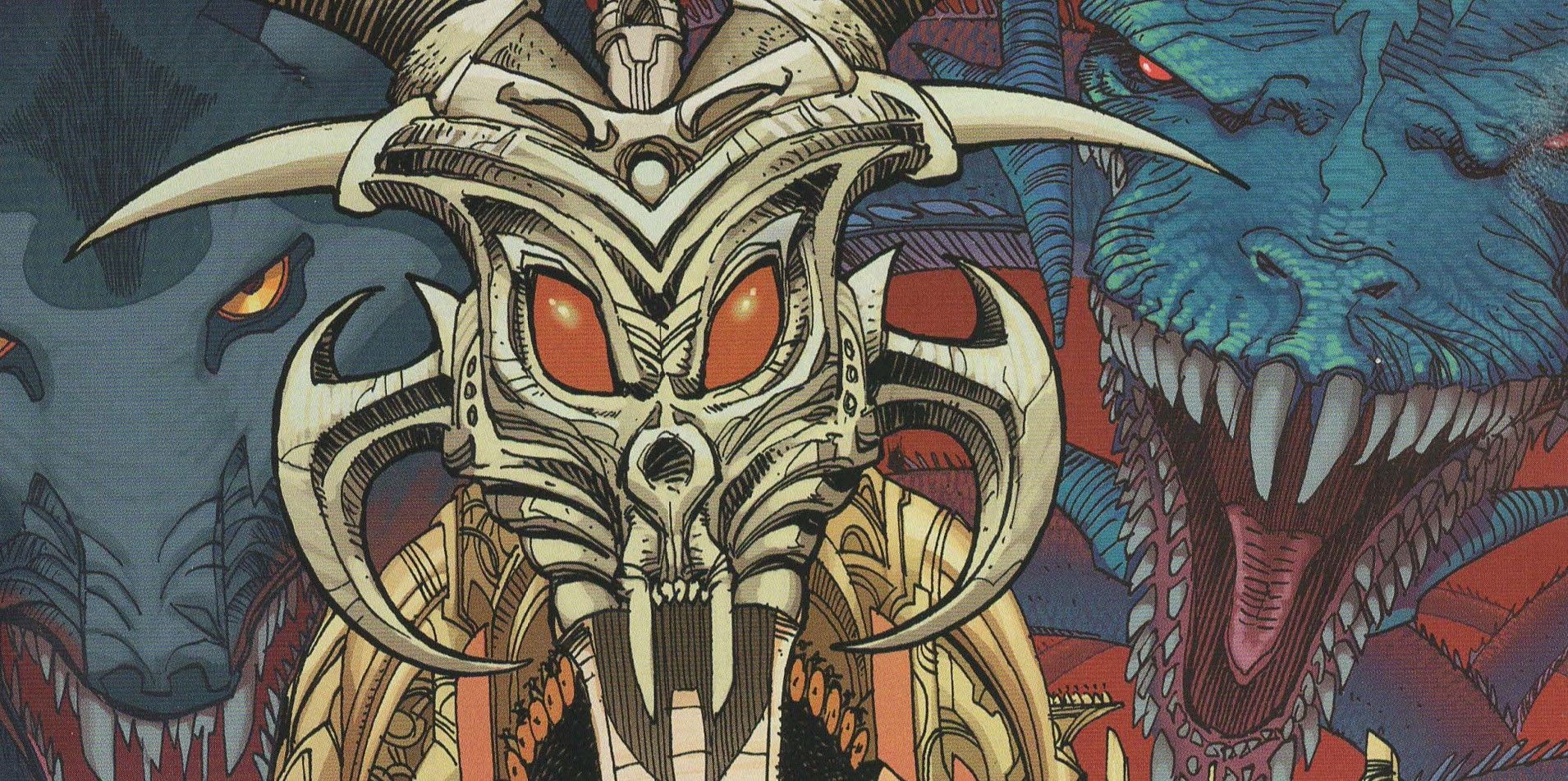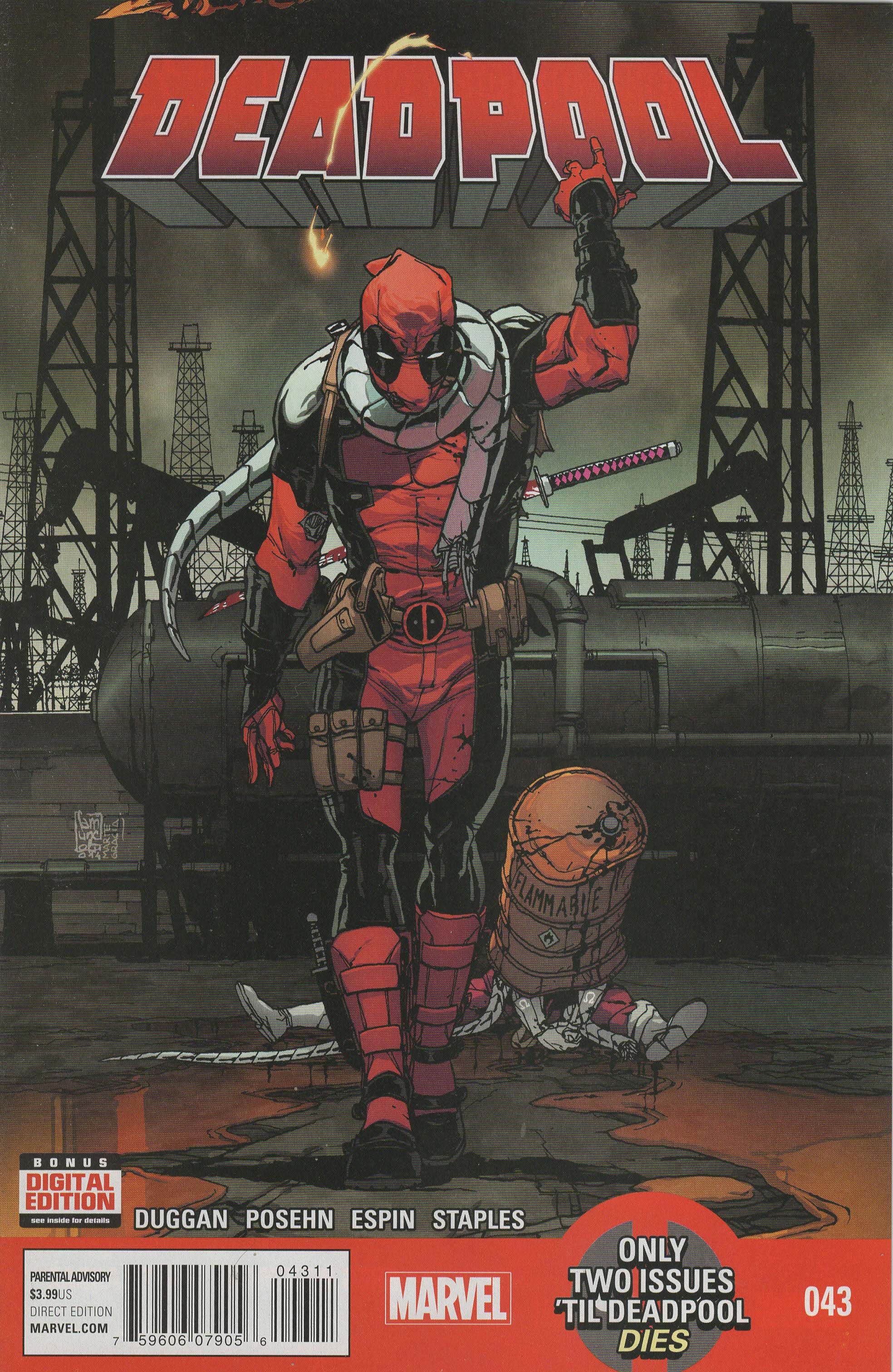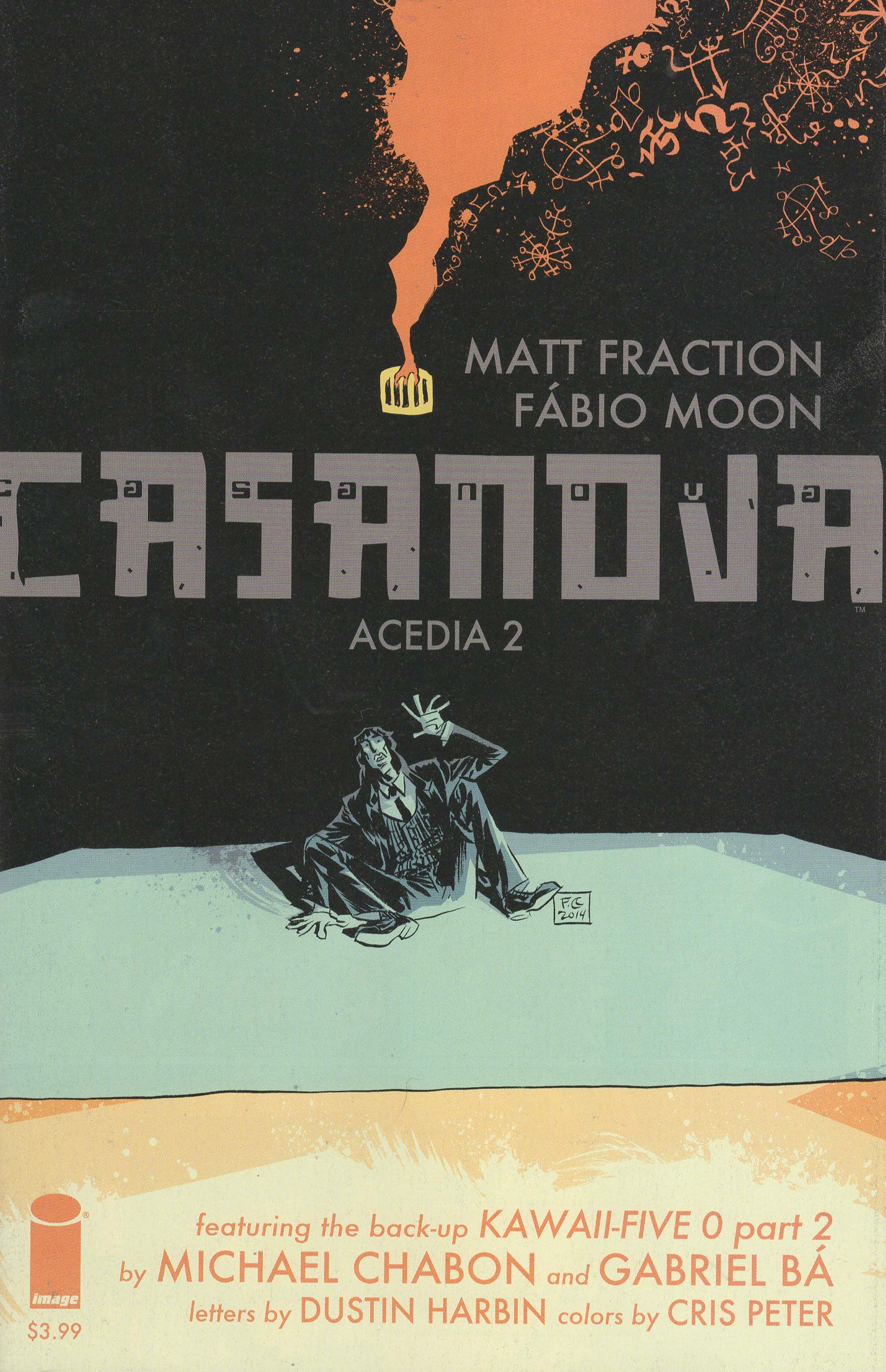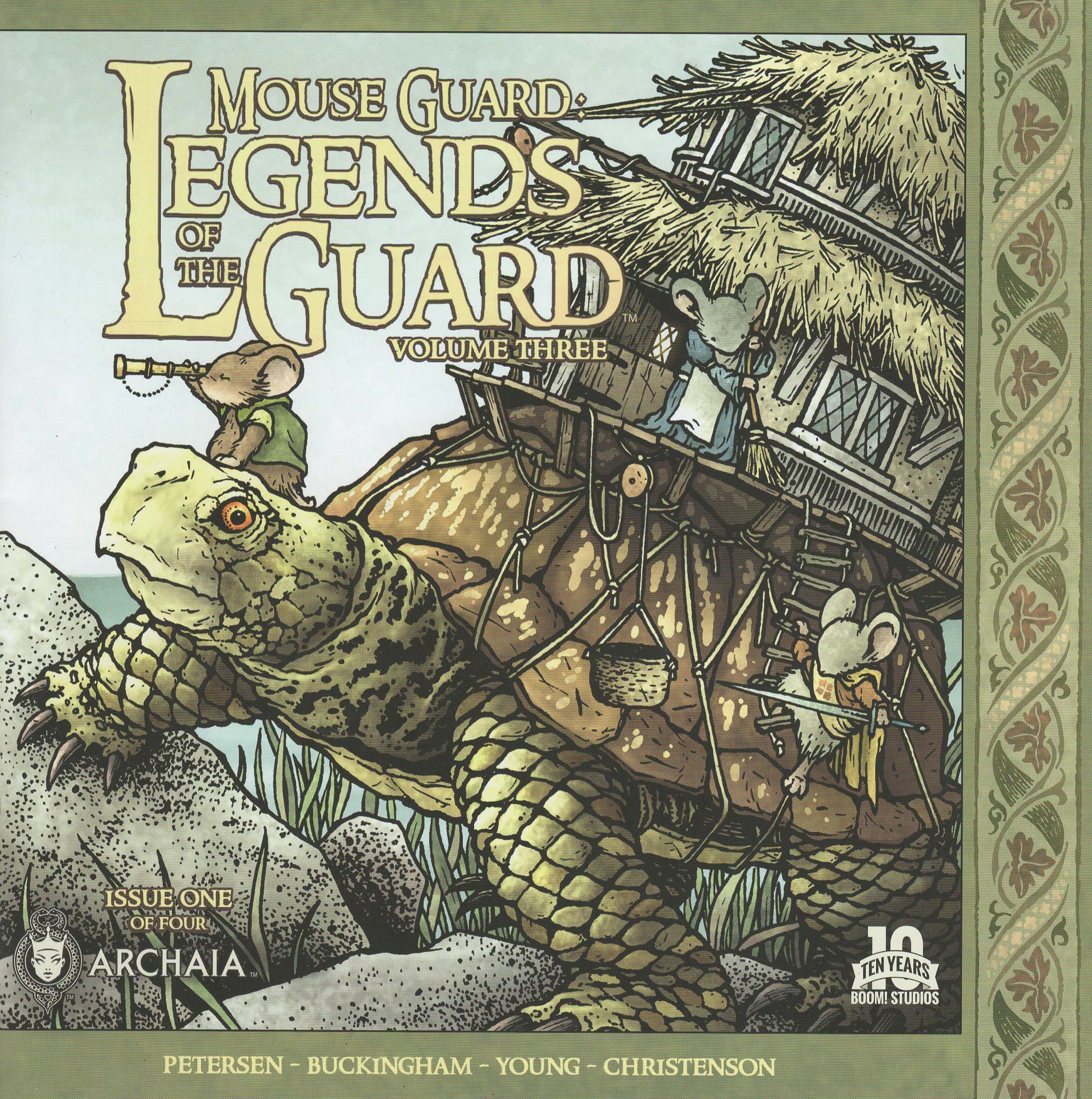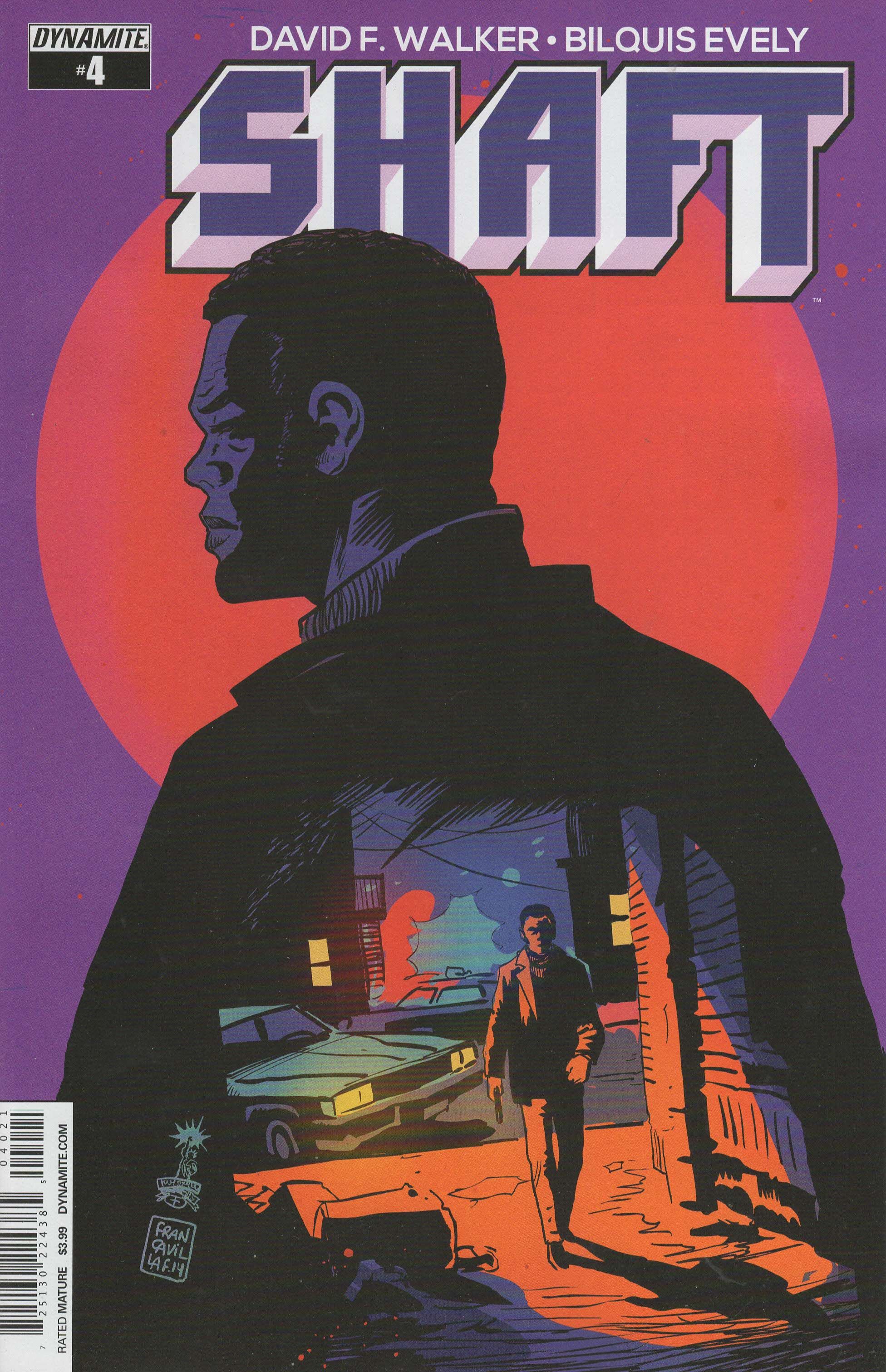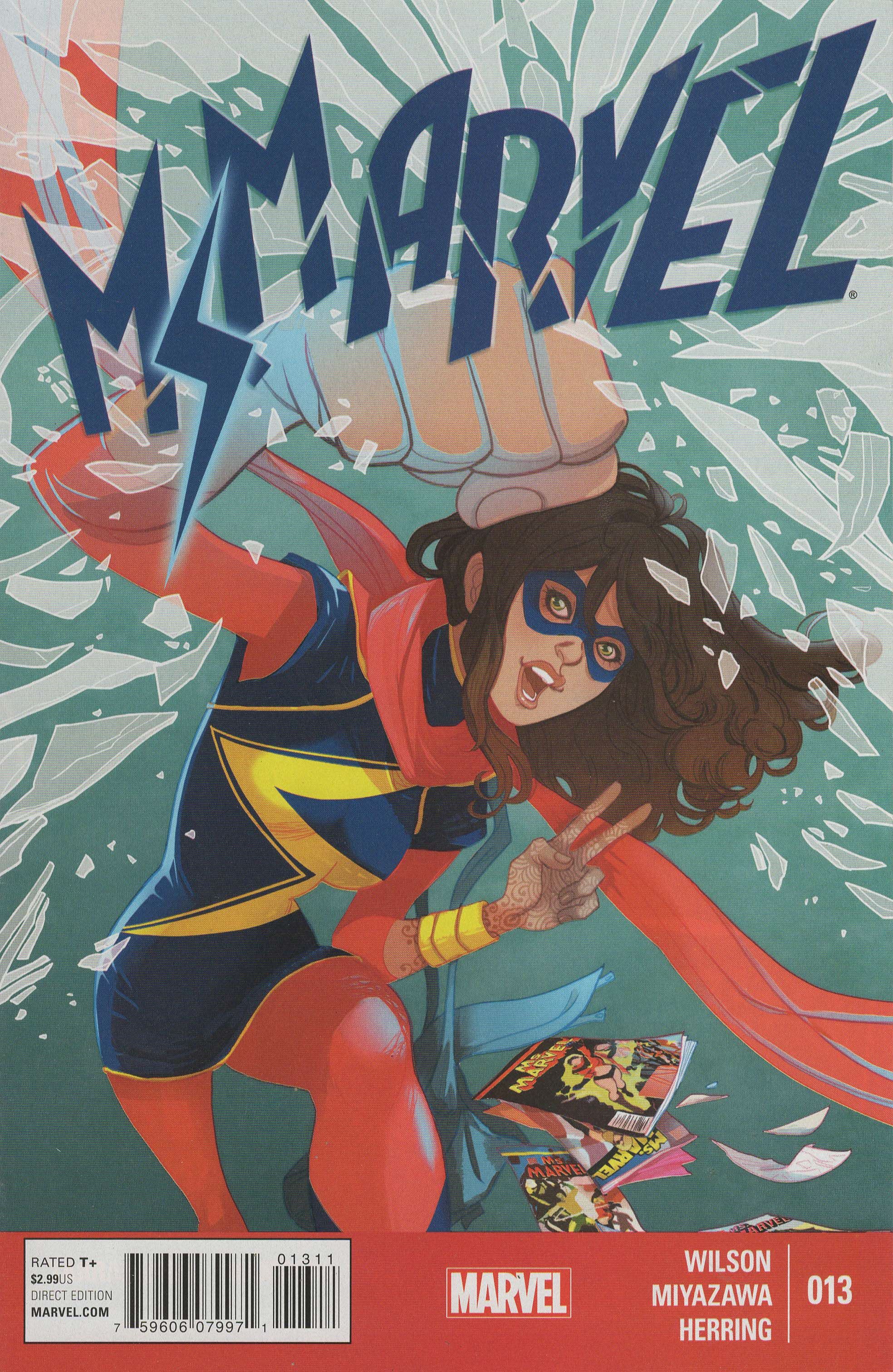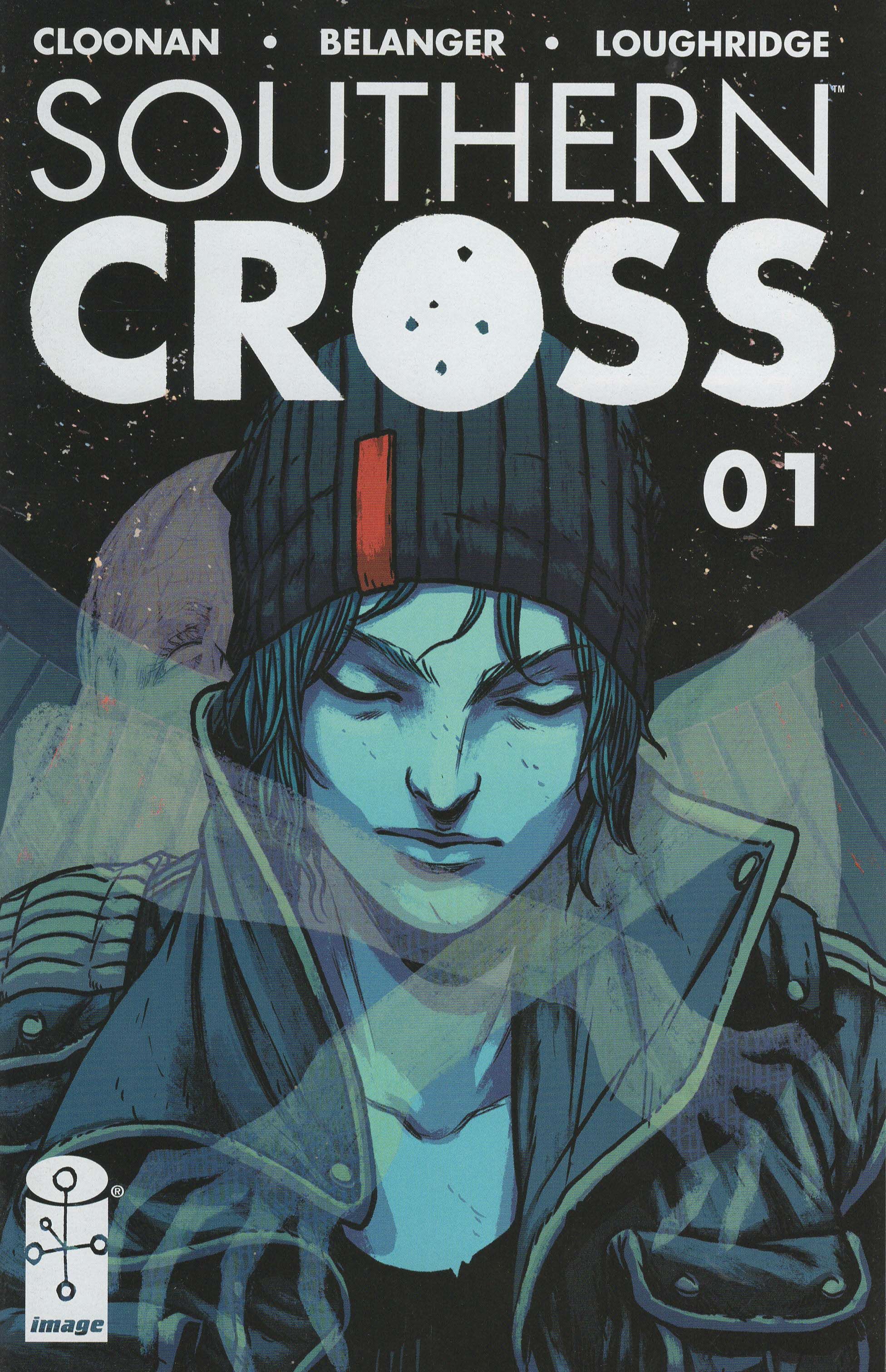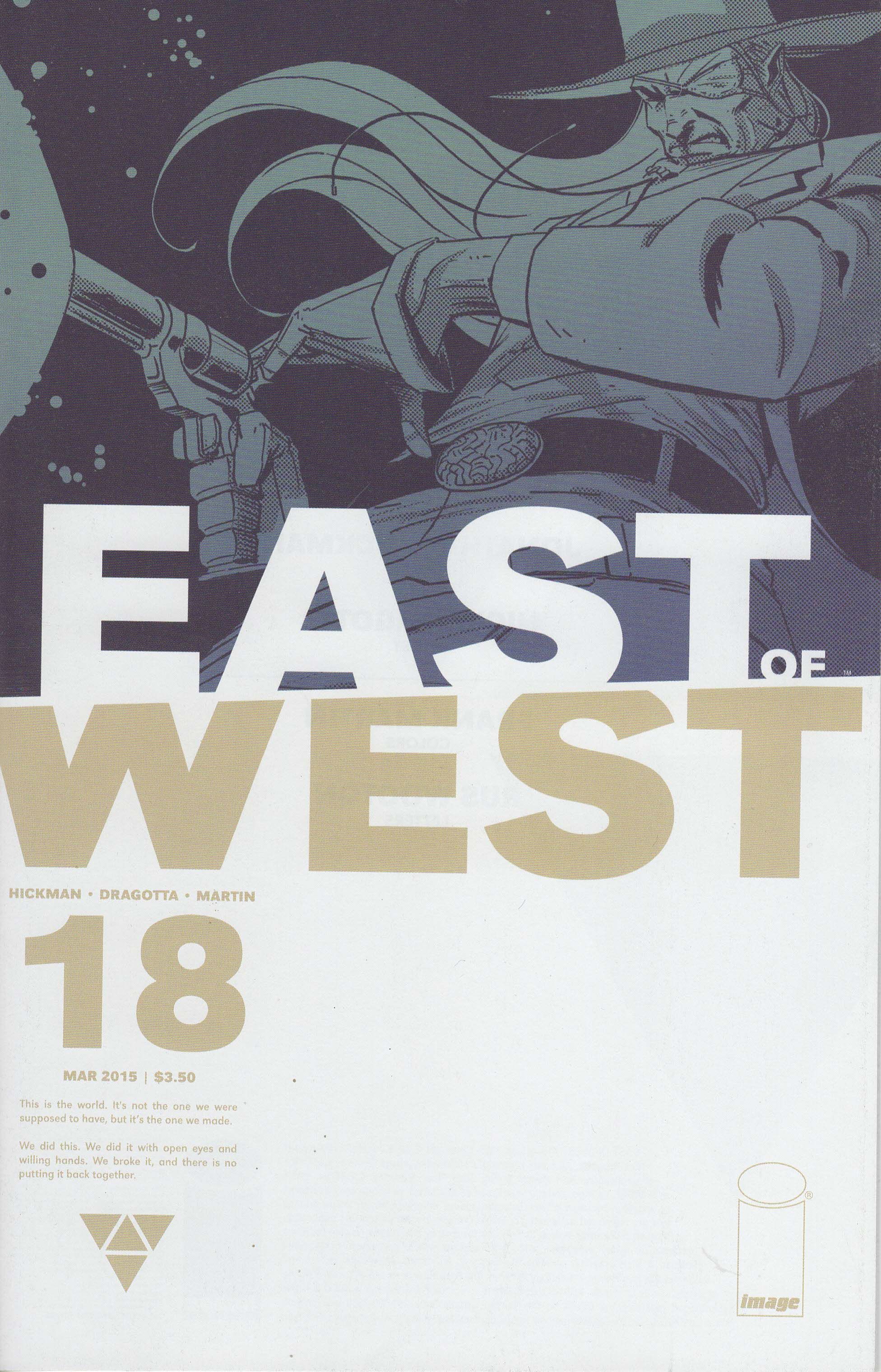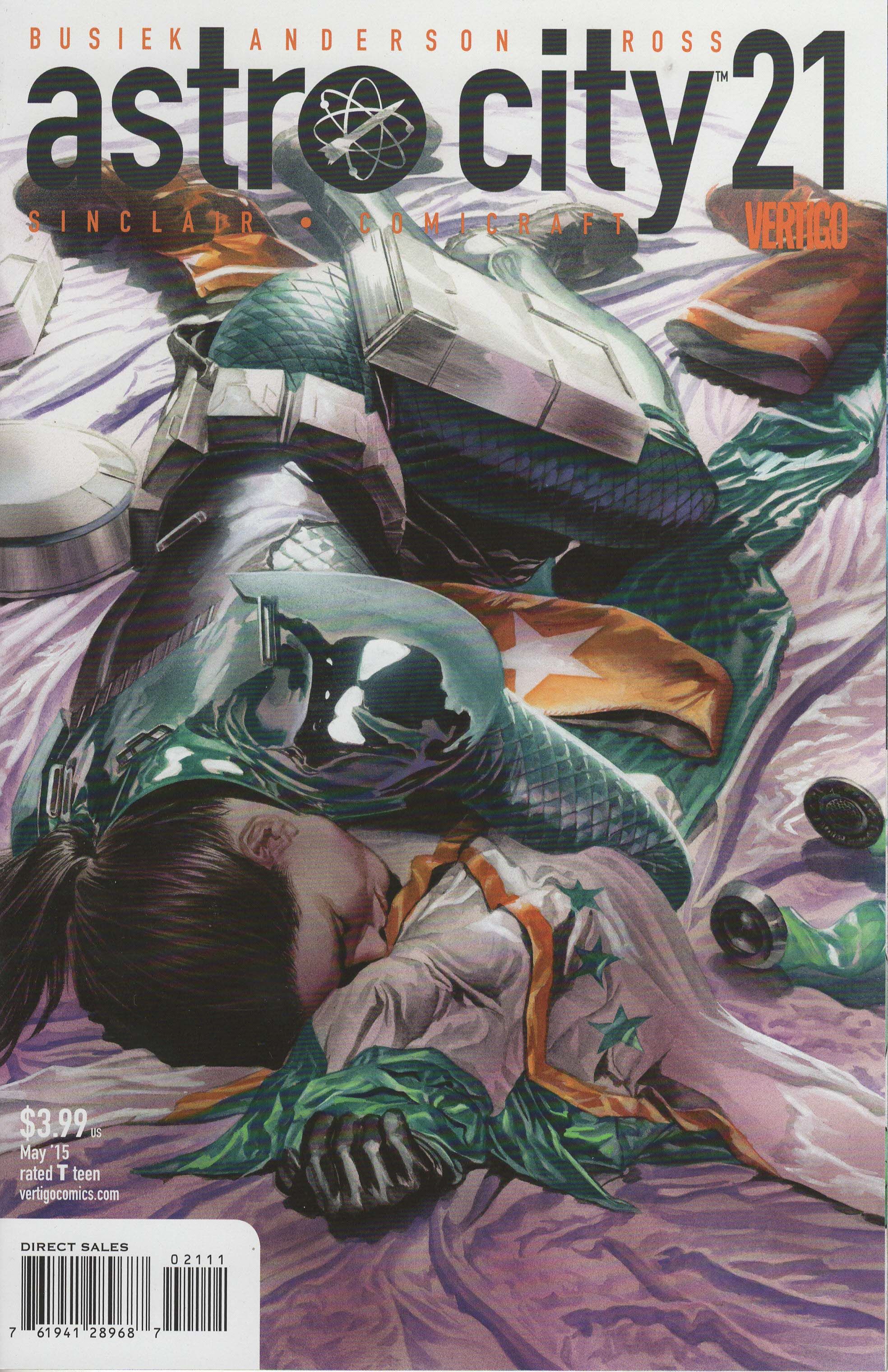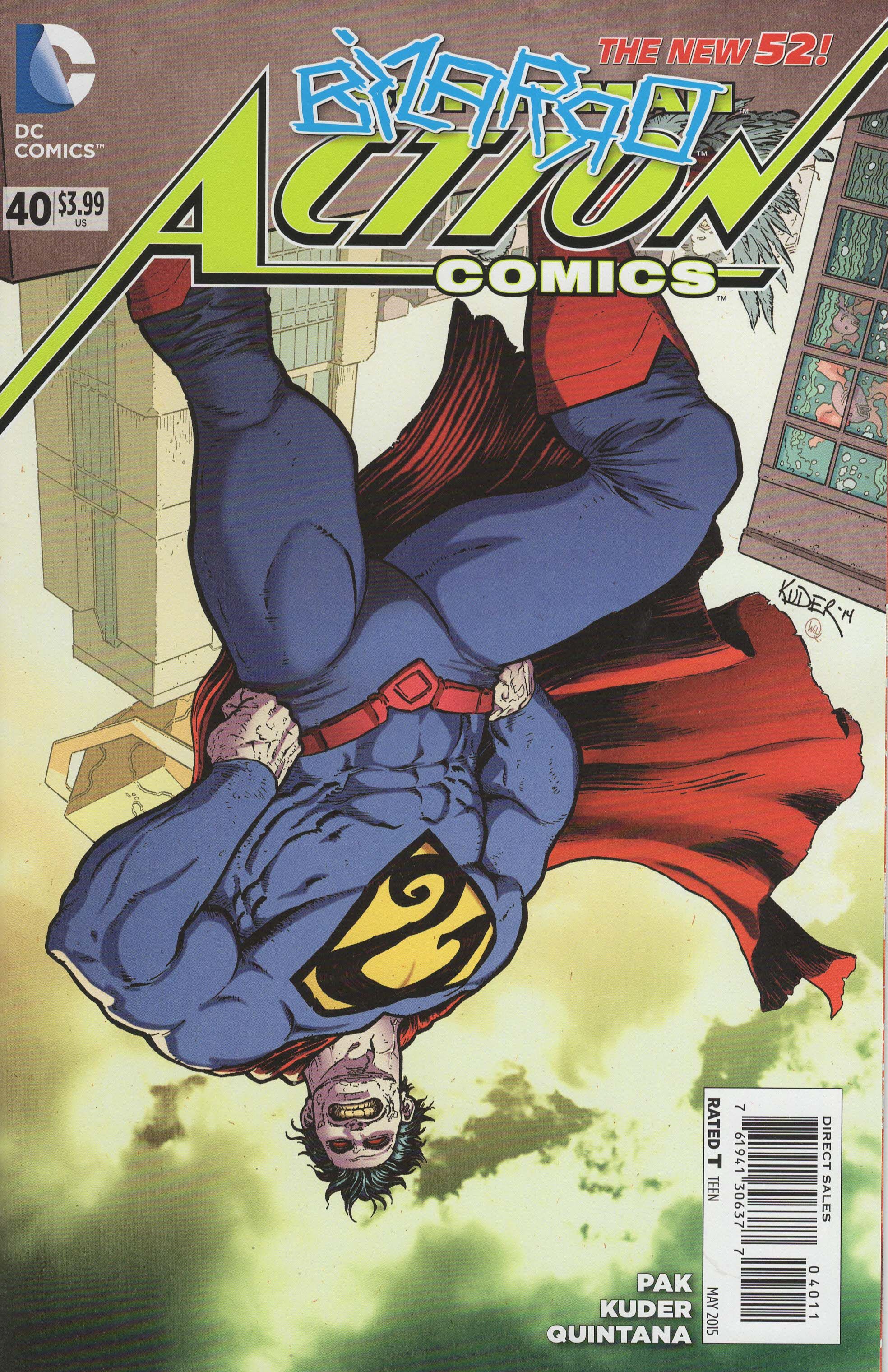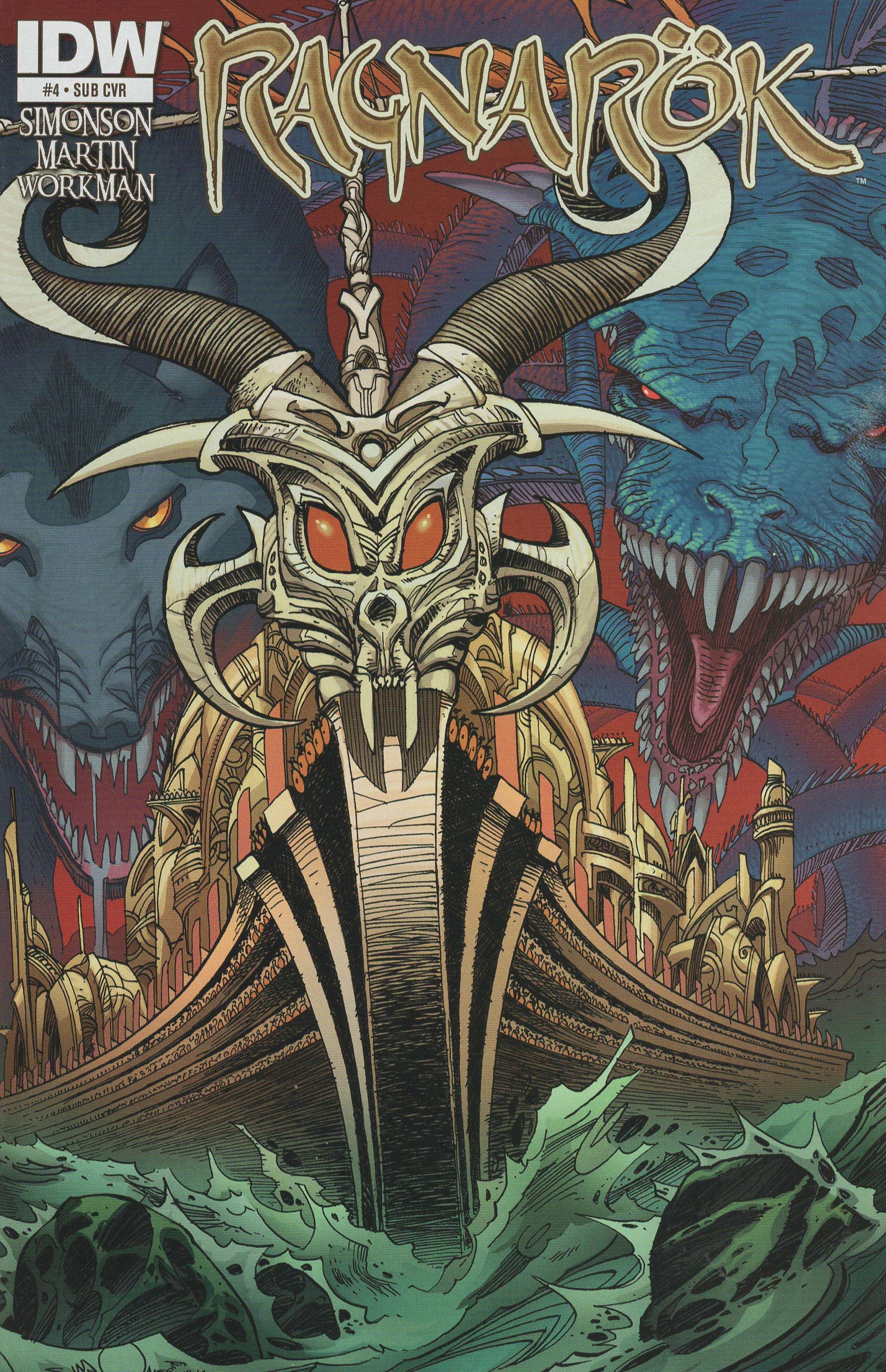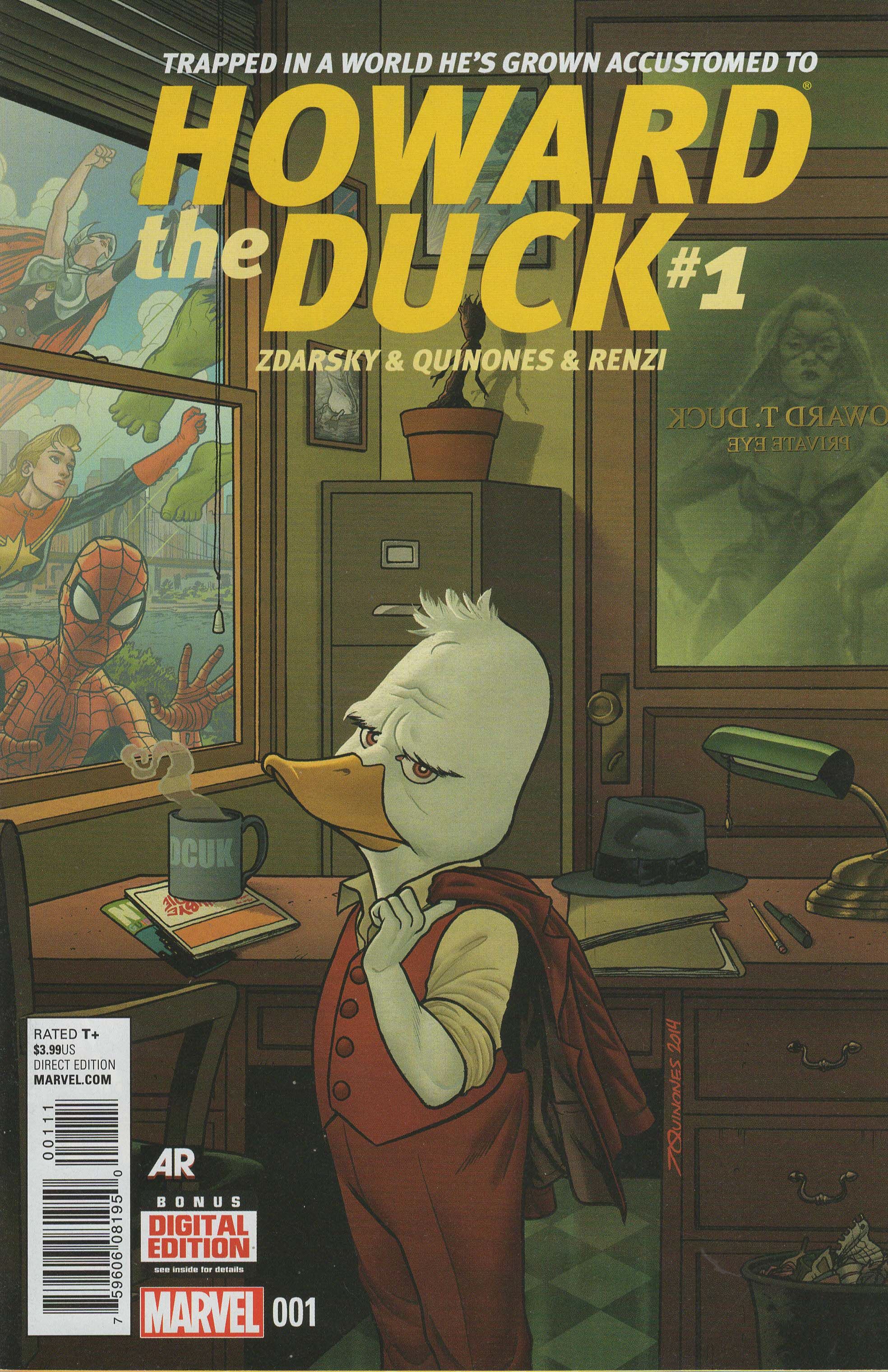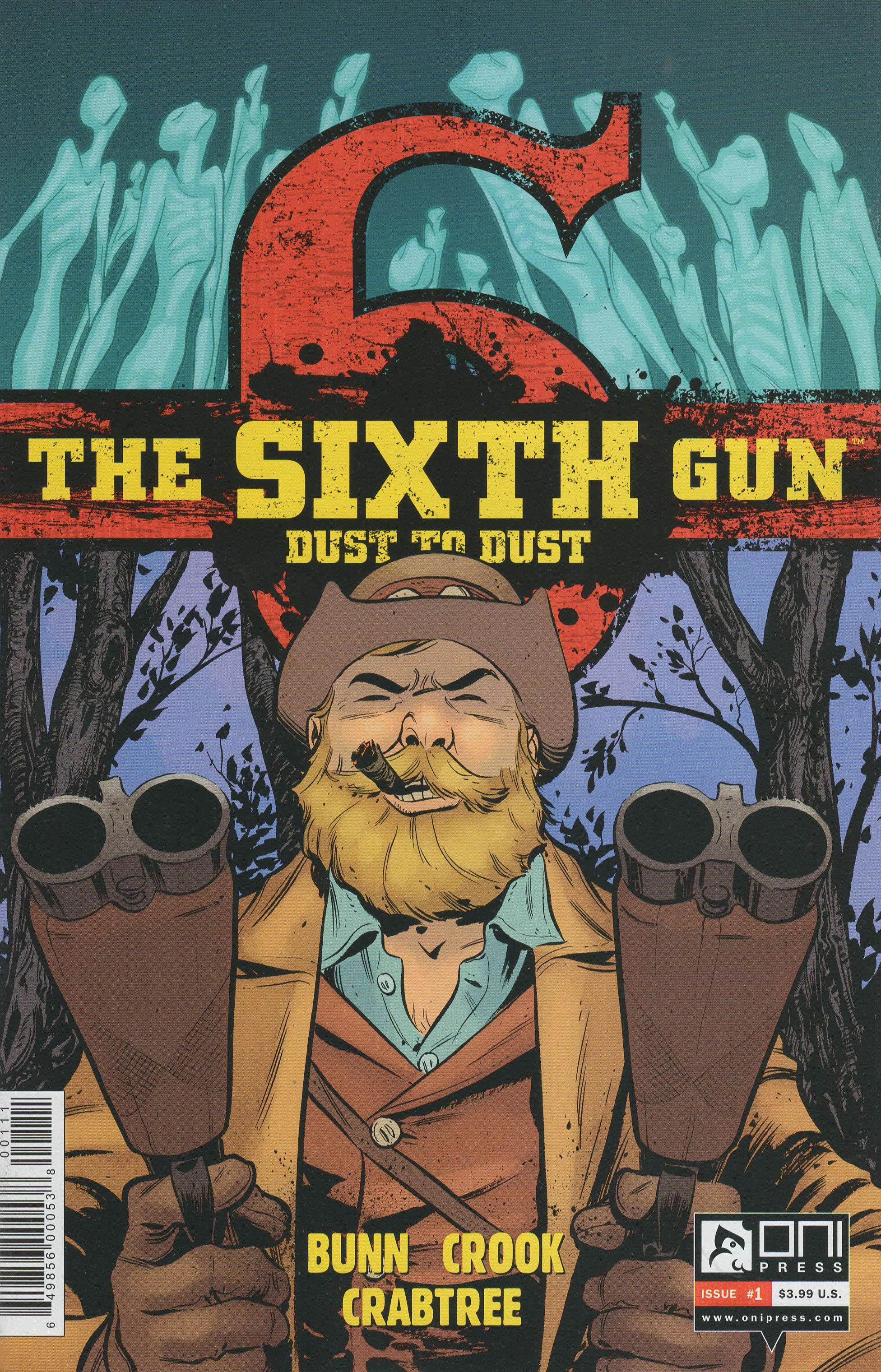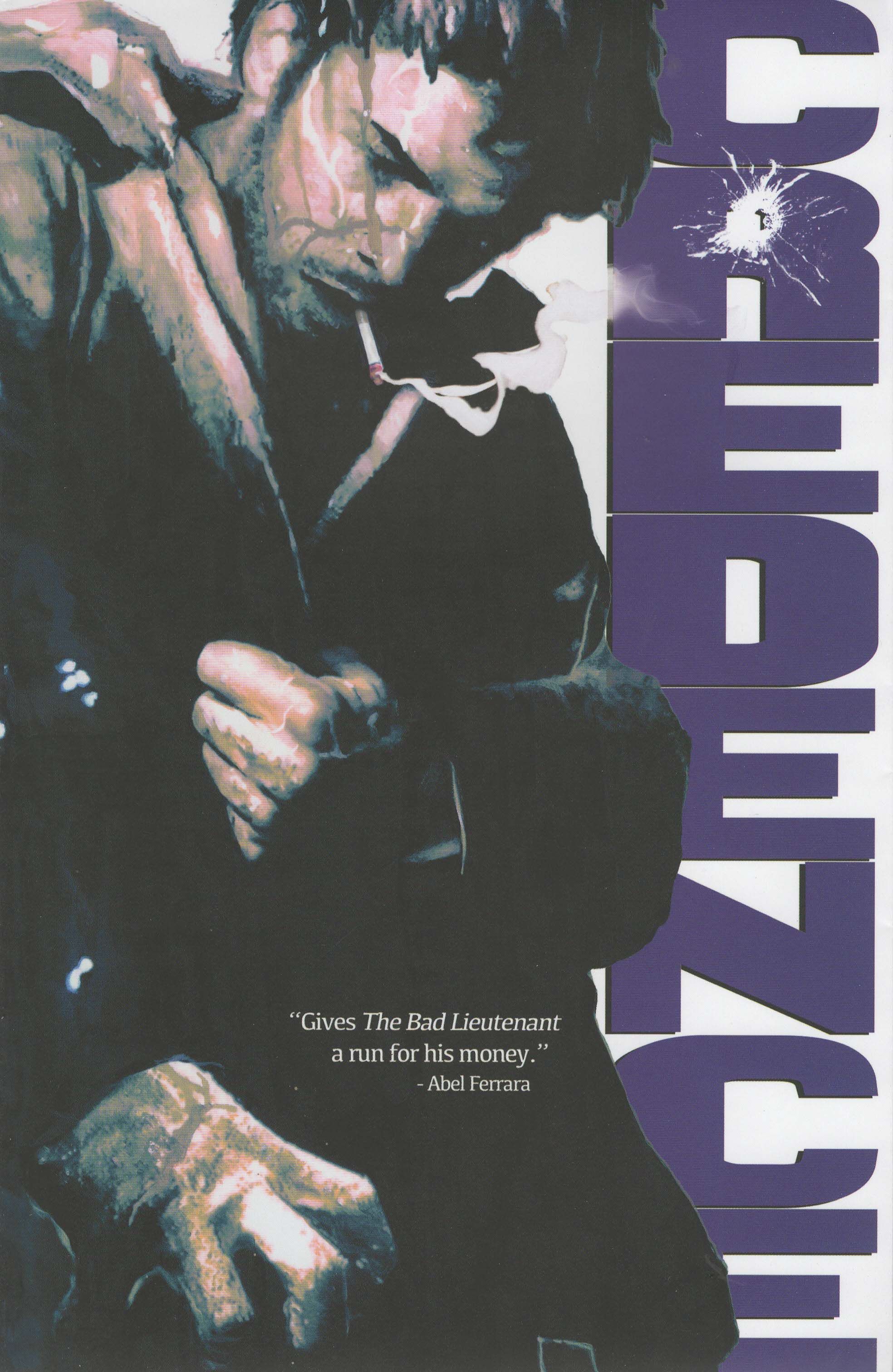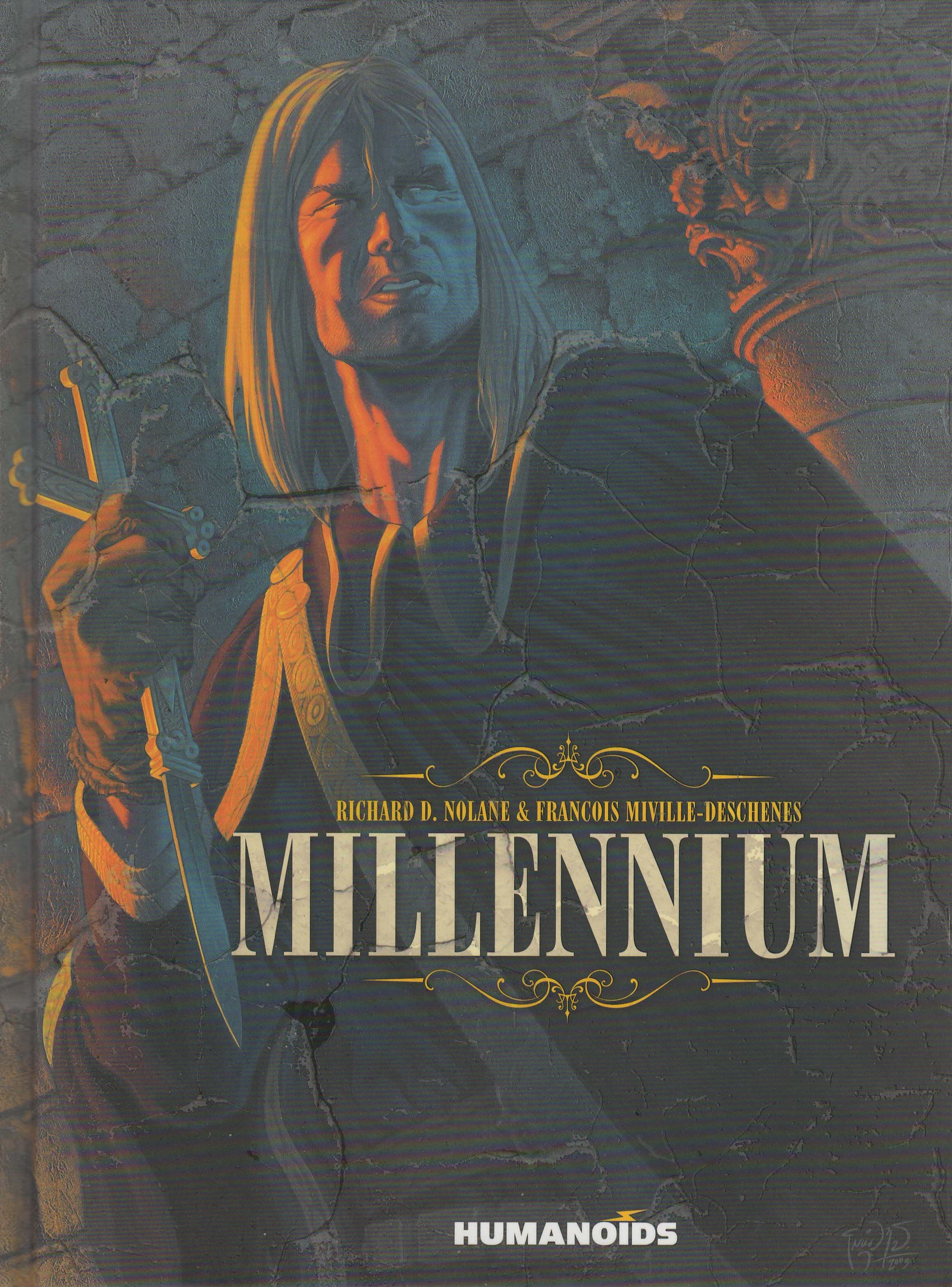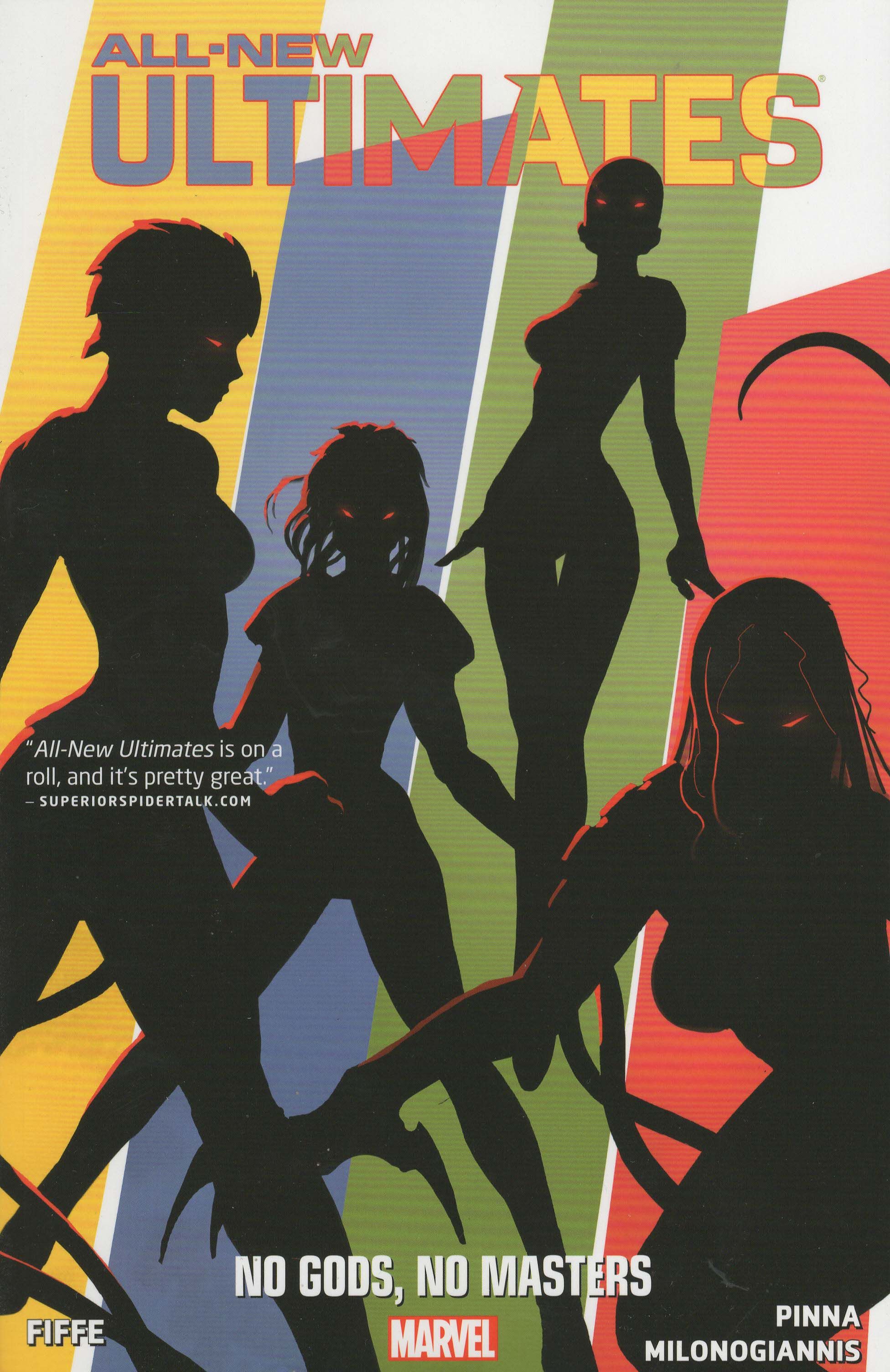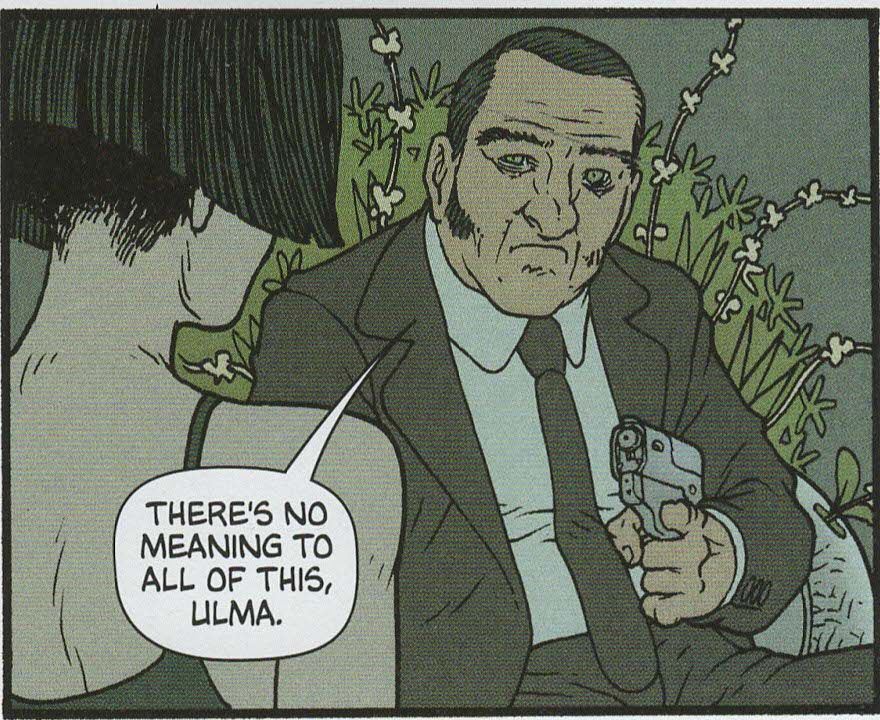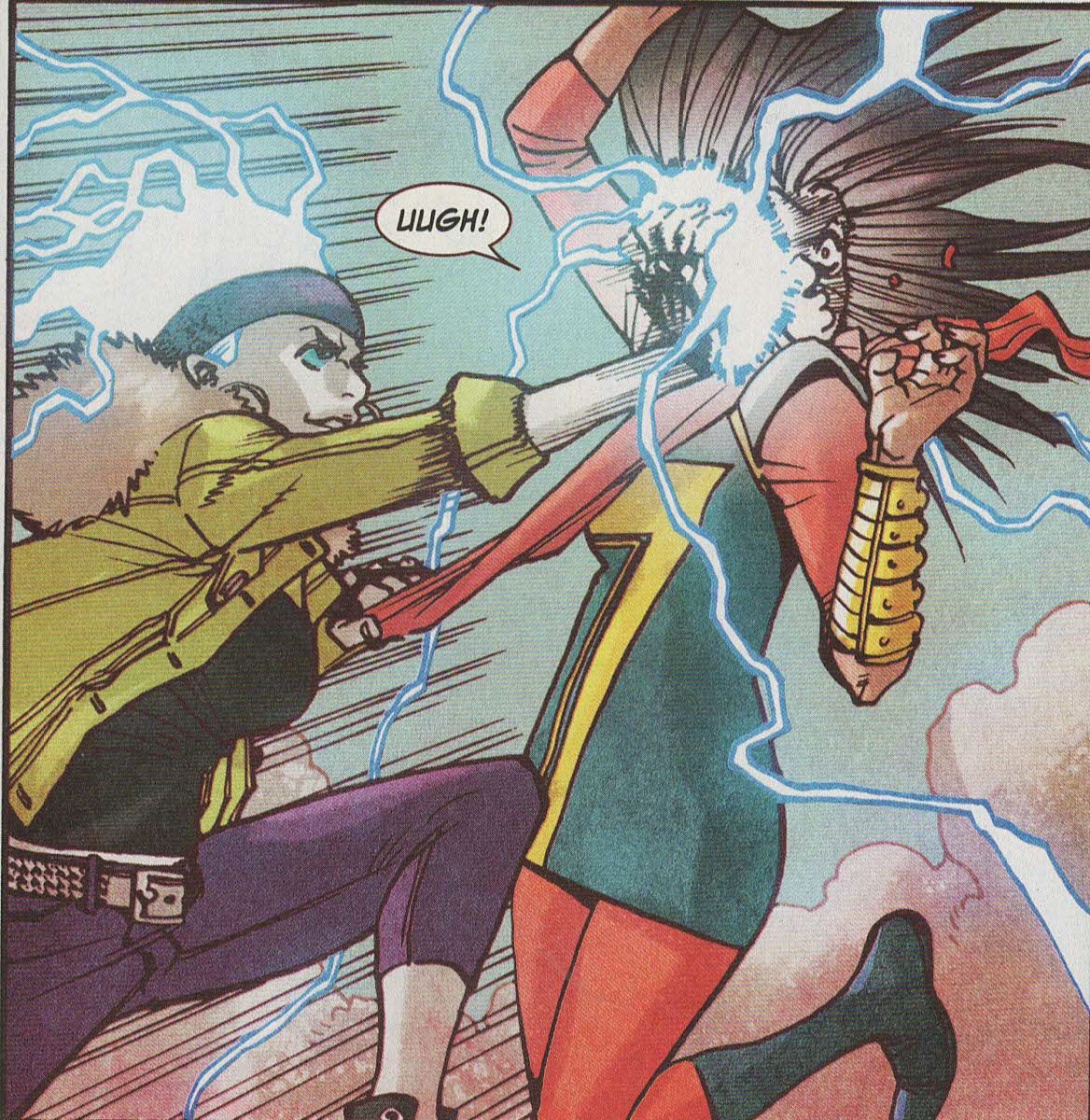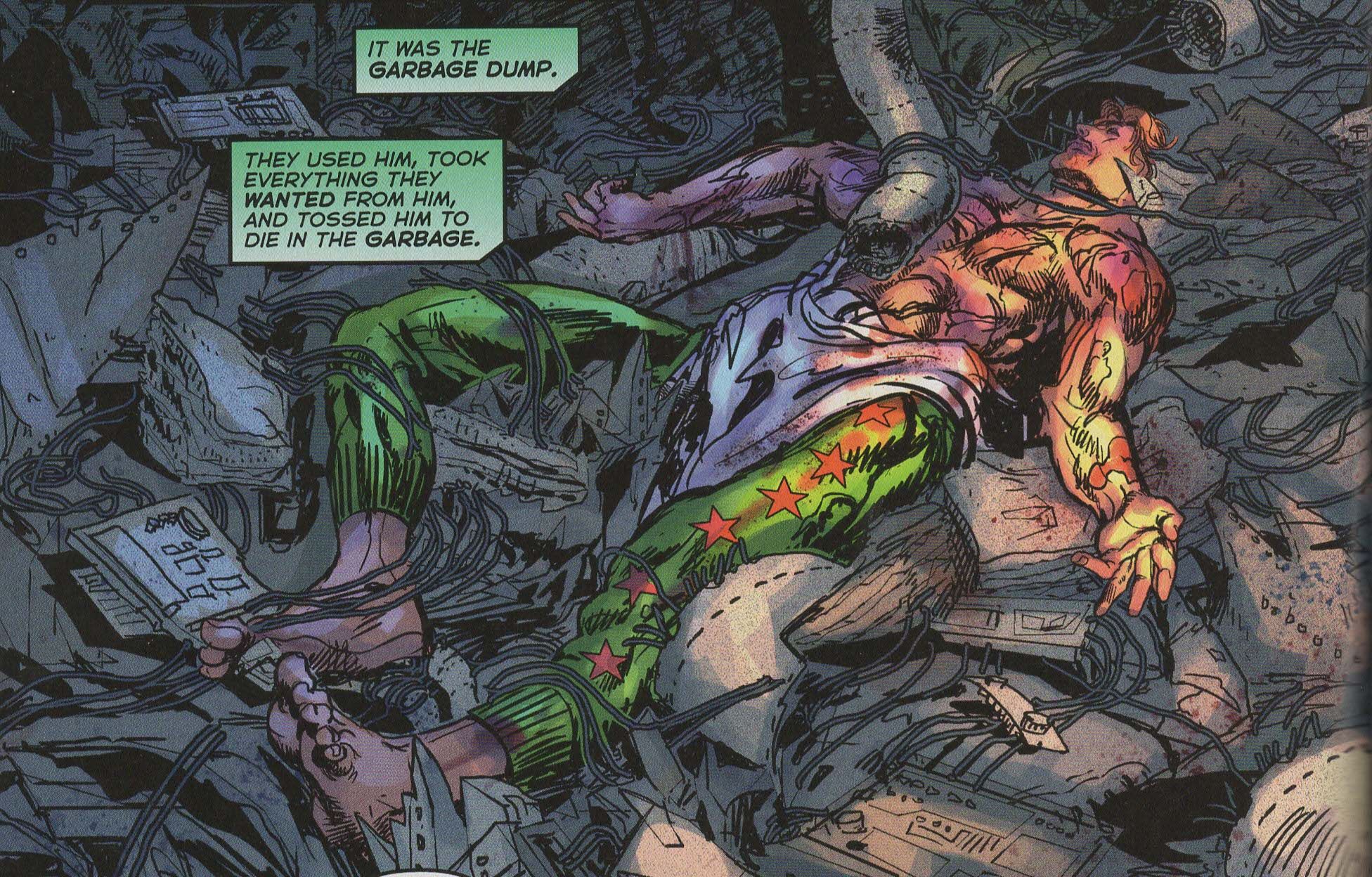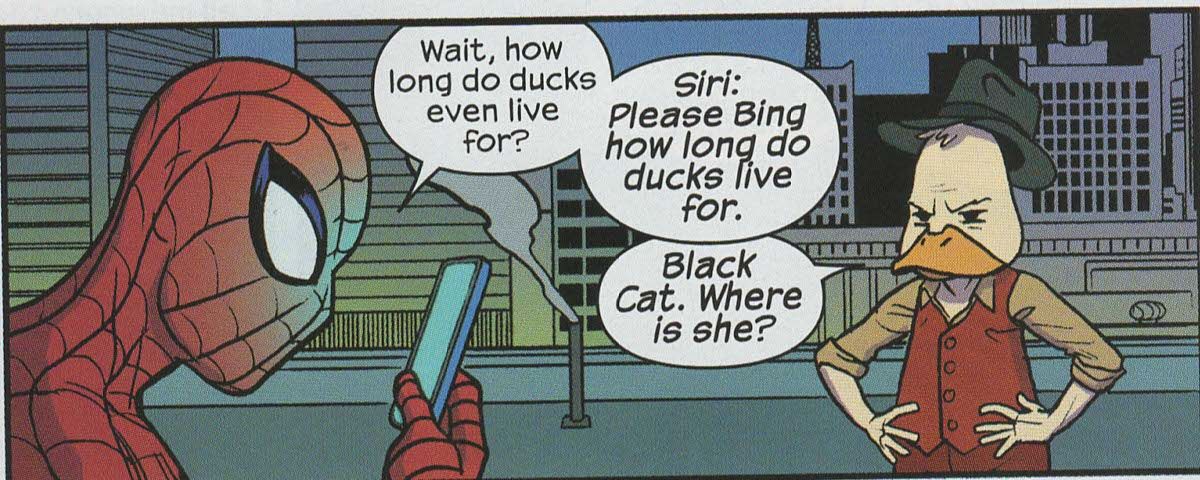Critics are like medical students: they always think a writer is suffering from the very disease they happen to be studying at the time. (Milorad Pavić, from A Landscape Painted With Tea)
The Surface #1 ("In a Beautiful Place in the Country") by Jordie Bellaire (colorist), Clayton Cowles (letterer), Langdon Foss (artist), and Ales Kot (writer). $3.50, 29 pgs, FC, Image.
Ales Kot hasn't been writing comics for too long, but he's really a fascinating figure already. I'd love to meet him, because from a distance, I can't decide if he's a genius or an idiot. He writes comics that challenge you, both in the ideas he throws out and in the very way you have to read them, but some of them don't cohere very well, and some reek a bit of pretension. The problem with Kot's comics is that they're out of the box, which makes them inherently compelling, because very few writers are trying to do what he does, especially at a mainstream level. He creates these comics that are bursting with weird ideas, and you think, "Man, this is something, isn't it?" I haven't yet decided if it's all bullshit, though. Then there's the idea of the "fictional" Kot versus the "real" Kot. Writers have written about how they come up with things forever, of course, and comics are no exception. One thing I have never liked about Casanova is Fraction's penchant for back matter, which always seem to boil down to "I'm having a really hard time with life, so it makes writing this ultra-cool spy comic that much tougher." He has wisely ditched the back matter in the latest arc, but he's not the only one who does it (and I don't hate all back matter, to be fair, but I tend to think the less, the better). Kot does it in this comic, and he integrates it into the actual story, as two pages of this comic are an interview with an "elusive writer" who is either the actual Kot or a thinly-veiled version of him. This is where I get back to Who Is Ales Kot? The writer in the interview comes off as someone riddled with self-doubt, and I'm not sure if that's the "real" Kot or a fictional version who's supposed to sound like that. If it is the "real" Kot, what's the point? If it's a fictional version and it will somehow tie into the rest of the story, that's fine, but it's a measure of how enigmatic Kot is that I have no idea what's what. But is that genius or idiocy?
I have a feeling it's a "fictional" Kot, mostly because one thing Kot has done in his comics is examine and break through the barriers between reality and fiction but without really doing so because, after all, it's all fiction. Kot constantly subverts our expectations in his comics, even if we have only the ones we build up from reading that sole issue. So he introduces characters and immediately starts tearing them down before they even have personalities to speak of. On the third page of Gomez's and Nasia's existence, Gomez buys coffee from "Starnuts," rejects the barrista's offer to purchase a band's album because he "liked them before they sold out," and is castigated in the very next panel by Nasia because he bought coffee from a conglomerate. There are so many levels of irony in three panels that it almost leaves you breathless, and we know almost nothing about Gomez and Nasia at this point. Kot does this constantly - he introduces themes and then immediately dismisses them, brings up plot points and then walks them back, and jams tension in inexplicable places and then dissipates it, all quickly and blithely, as if he's just trying them out. Like Morrison and Ellis, he spouts pseudo-scientific bullshit that sounds brilliant but walks a fine line alongside stupidity. His characters speak cleverly but rarely become much more than plot devices, although there are traces of the depth within them (which is occasionally facilitated by the artist; Foss's sad-eyed rendition of Mr. Loki, for instance, is terrific). Like most of Kot's comics, there is a distance between the reader and the text of The Surface, which makes its title all the more prophetic. As with all of Kot's comics, The Surface is full of stuff that sounds like it could be brilliant, but also as with all of Kot's comics, the key will be whether he can communicate that stuff coherently. I know it's not for everyone, but I find that tension much more interesting than "Kot" blathering on about whether this comic will actually work. The "interview" is just Kot talking bullshit about art and magic, peppered with what he fears about this series and whether it will convey what he has in his head. Hey, you know what will answer that? The actual comic. How about we just read that?
The art is very nice, though. There is that.
The Surface is another chance for me and everyone to decide what the heck is up with Ales Kot. I do appreciate his approach. Whether it ever turns into great art is something we'll have to discover. But that's what makes art fun.
Rating: ★ ★ ★ ★ ★ ★ ★ ☆ ☆ ☆
One totally Airwolf panel:
Deadpool #43 ("After Mash") by Gerry Duggan (writer), Salva Espin (artist), Brian Posehn (writer), Joe Sabino (letterer), Val Staples (colorist), Charles Beacham (assistant editor), and Jordan D. White (editor). $3.99, 20 pgs, FC, Marvel. Deadpool created by Fabian Nicieza and Rob Liefeld. Omega Red created by Jim Lee and John Byrne. Trapster created by Stan Lee and Jack Kirby.
In this comic, Deadpool gnaws his own arm off to escape from the chains from which Omega Red hangs him. I honestly don't know what else there is to say about it.
Rating: ★ ★ ★ ★ ★ ★ ★ ½ ☆ ☆
One totally Airwolf panel:
Casanova: Acedia #2 (of 4) ("O Killers I Have Known and Loved"/"The Metanauts: Kawaii-Five O") by Gabriel Bá (artist/colorist, "The Metanauts"), Michael Chabon (writer, "Metanauts"), Matt Fraction (writer, "O Killers"), Dustin K. Harbin (letterer), Fábio Moon (artist, "O Killers"), Cris Peter (colorist, "O Killers"), and Lauren Sankovitch (editor). $3.99, 28 pgs, FC, Image.
A while back, FotB T. made an observation about Matt Fraction, how perhaps Casanova really isn't a good comic, based on Fraction's track record on other comics, and only the hazy gauze of nostalgia made people think it was a good comics. I'd find the comment, but I don't feel like searching for it, but it was something in that vein. T., of course, is one of this blog's oldest commenters (not in terms of age, but in terms of how long he's been reading) as well as being one of its most garrulous contrarians, but he's also a very smart dude, so I always appreciate his comments and think about them even when he's ranting about how David Michelinie is the world's greatest villain. I thought about his question about Casanova, because it could be true - the book dropped very early in Fraction's career, and it was probably his most high-profile book he had done at the time (he wrote the lead story in X-Men Unlimited #9 in 2005, but I don't know if that really counts). He had shown potential - Mantooth and Five Fists of Science are both good - but Casanova was a different animal altogether. The "slimline" format - 16 pages of story for $1.99 - meant, it seems, that Fraction had to get as much as he could into each issue, and therefore Casanova read like a high-octane shot of awesomeness, as if Fraction couldn't slow down even for an instant. Not long after that, he went off to Marvel and became a superstar. But is he a good writer?
There's some evidence to suggest he's not good, of course. These days, whenever writers go off to Marvel or DC, I worry about them because whatever made them attractive to Marvel and DC in the first place is squashed once they arrive. Only after gaining some measure of sales cachet can they revert to the writers that lured the Big Two to them, which makes no sense, but whatever. Early in his Marvel tenure, Fraction teamed with a proven commodity, Ed Brubaker, to give us Iron Fist, which remains the best thing he's done for the company. The Order was an interesting failure, but Marvel still liked him enough to give him Iron Man, which was a pretty big success. I absolutely hated the first five issues of the series, so I dropped it. I guess it has its fans, which is nice. He also began writing Uncanny X-Men, which I bought for a year before giving up on it. The key thing is that these two books were drawn by Salvador Larroca and Greg Land, two of my least favorite artists working right now (I once liked Larroca's work, but that was long ago). Was Fraction sucking because his artists were terrible? He continued to write these books for a while, which is why I wasn't reading a lot of Fraction's work. Then in 2011, he got a chance to write a big Marvel event, and we learned that Franklin Delano Roosevelt was weirdly talking about Marvel comics when he said "We have nothing to fear but Fear Itself." Who knew? He wrote Thor (which I didn't read), and Defenders (which I did), and while the latter book had its moment, it also felt like Fraction was trying a bit too hard. In August 2012 Hawkeye #1 came out, and that's been Fraction's most critically-acclaimed Marvel comic. Fraction has written some great single issues for that series, but overall, it feels like a missed opportunity, and for someone who once crammed as much plot as he could into an issue of Casanova, the fact that Hawkeye has has, essentially, one plot for the Clint Barton part of the book for its entire run is maddening (the L.A. story arc was gossamer-slight, too, but hey! it was a brief detour away from the main plot, so yay!). I like Hawkeye, but it seems like it could have been a lot better. Then Fraction wrote a godawful first issue of Fantastic Four (I have no idea how good or bad the rest of the series was, because that first issue angered me so much), a decent first issue of FF (and I guess this was better than his Fantastic Four, but how could it not be?), before he returned to Image with Satellite Sam and Sex Criminals. I got both of those, because I figured that with Fraction escaping the constraints of corporate-dominated comics, he could be the Fraction I fell in love with. Neither of them were any good, though. I know many cognoscenti love Sex Criminals, but I thought it was pretty lousy and Fraction's views on sex (both in it and Satellite Sam) were pretty puerile. Those were the comics that actually made me consider that T. knew what he was talking about.
But here's the thing: Through it all, he's been creating new issues of Casanova. Marvel reprinted the old series for a while, and at the same time that Marvel was inflicting Fear Itself on us, a new arc of Casanova came out ... and it was excellent. "Avarita" ended in June 2012, and now, almost three years later, we're finally getting "Acedia" (which, according to Wikipedia, "describes a state of listlessness or torpor, of not caring or not being concerned with one's position or condition in the world. It can lead to a state of being unable to perform one's duties in life. Its spiritual overtones make it related to but arguably distinct from depression"). So while he's writing bad comics like Fear Itself and painfully almost-great ones like Hawkeye and critically-acclaimed-but-really-crap (you know, because I say so) like Sex Criminals, he's writing Casanova. And crushing it. It's not nostalgia, I don't think. I actually went into issue #2 thinking about T.'s comment from lo those years ago, and I actively thought about it while I was reading this issue. Was it any good, or was I holding on to an experience that just wasn't as good as I thought it was?
Well, obviously I'm not an objective robot, so anything I say is an opinion and must be taken with a grain of salt (my contrariness regarding the love of Sex Criminals proves that point). But I still love Casanova. I don't know how Fraction does it. He doesn't write more eloquently on this comic, and his prose tends to remain at least somewhat accessible (on some issues of the comic, he gets a bit weird, but not in this issue, at least). His banter, which grated on me in Sex Criminals and can be annoying on Hawkeye, tends here to be more charming, perhaps because of the way he's established Casanova Quinn's character. His characters speak just elliptically enough to be intriguing but not so much that it bugs me. He builds tension terrifically. His humor is far funnier than in anything else he's written (well, with the possible exception of Mantooth, but that was a long time ago), perhaps because it's not as juvenile as in other comics (once again, I'm looking at you, Sex Criminals). The mystery is puzzling but not too opaque, and the elements of the story are easily picked up even though the specifics might be a bit difficult to remember (it's been over two years, after all). Even the book Kaito is reading while Casanova talks to the mysterious woman who tried to kill him in issue #1 is hilarious.
Obviously, a good deal of the tension in this issue comes from Moon's amazing art, especially when the demon appears (see below). Moon and Bá are probably the best artists Fraction has ever worked with (with apologies to David Aja), and while I don't doubt that they are a big reason for the book's success, Aja's wonderful work on Hawkeye can't cover up some of the cracks in that book. If we just look at the script, Fraction's words are so much better here than they are in almost everything else he's written. His plotting is tighter, his dialogue is better, and his characterization is richer. I know it's a labor of love, but it's kind of weird. As I noted above, some of his Marvel work is quite good, but this is on a different level.
So what do we make of Fraction? There are examples of people who create one transcendent work of art and never quite reach that pinnacle again. I've mentioned some of them before with regard to Fraction, so I won't do it again. I have no doubt that he's a good writer who can write some amazing comics that aren't called Casanova, but that Casanova remains his magnum opus. There's nothing wrong with that, of course - everyone wishes they had one masterpiece in them. But even if I dislike a good chunk of Fraction's output (and like a decent chunk of it, too), it's comforting to know that somewhere out there, the next issue of Casanova is taking shape. And someday in the future I'll get to read it.
Rating: ★ ★ ★ ★ ★ ★ ★ ★ ½ ☆
One totally Airwolf panel:
Mouse Guard: Legends of the Guard volume 3 #1 (of 4) by Mark Buckingham (writer/artist, "The Gosling and the Ghost"), Hannah Christenson (writer/artist, "The Armor Maker"), Lee Loughridge (colorist, "The Gosling and the Ghost"), Todd Klein (letterer, "The Gosling and the Ghost"), David Petersen (writer/artist, framing sequence; editor), Skottie Young (writer/artist, "The Mouse and the Moon"), Cameron Chittock (assistant editor), and Rebecca Taylor (editor). $3.99, 24 pgs, FC, Boom! Studios/Archaia.
I love Mouse Guard, and I love the anthologies that Petersen publishes in between story arcs, so here's another one! There's not much to write about here, though - Buckingham's story about a mouse hiring a Guard to get rid of the goose that's eating his grain is funny and predictably beautiful; Young's story looks great and tells a nice little parable; Christenson's gorgeous story is longer than most of the ones in these anthologies (8 pages instead of 6, like the other two) and tells an interesting tale about an armorer who wants to be a knight. All of the stories are good, but that's not a surprise. I'm just glad that these comics exist. They're awesome.
Rating: ★ ★ ★ ★ ★ ★ ★ ½ ☆ ☆
One totally Airwolf panel:
Shaft #4 by Bilquis Evely (artist), Daniela Miwa (colorist), David F. Walker (writer), and Joe Rybandt (senior editor). $3.99, 22 pgs, FC, Dynamite Entertainment. Shaft created by Ernest Tidyman.
As we are deep into the first (and only?) arc of this comic, there's not a lot to write about. Shaft continues to investigate, he meets more players in the drama, he discovers that dirty cops are involved (I know, shocking), and he finds a vital clue that leads him to a crucial point. Walker isn't doing anything new with the crime drama, but he tells it well, and that counts for something. Evely is still tremendous on the art, and Miwa's colors are wonderful. Evely evokes 1970s New York really well, from the interior decorating to the cars to the clothing, and she gives the book a terrific sense of the time, while Miwa's washed-out colors make the time period even more realistic (yes, I know "real life" wasn't washed out in the Seventies, but the representation of it makes the time period feel more real). Miwa uses the blue/orange complement to wonderful effect at the end of the book, when Shaft is the light out of the darkness for the person he's talking to, and so he's bathed in beatific orange while the other person remains shrouded in blue. The blue/orange complement is overused in comics and movies, but when it's done right, it's a really neat effect.
There's not much else to say. This is a solid comic with excellent art. That's often enough for me!
Rating: ★ ★ ★ ★ ★ ★ ½ ☆ ☆ ☆
One totally Airwolf panel:
Ms. Marvel #13 ("Crushed Part One of Three") by Joe Caramagna (letterer), Ian Herring (colorist), Irma Kniivila (colorist), Takeshi Miyazawa (artist), G. Willow Wilson (writer), Charles Beacham (assistant editor), Devin Lewis (assistant editor), and Sana Amanat (editor). $2.99, 20 pgs, FC, Marvel.
Last issue, I wrote that Bruno needed to nut up and tell Kamala he digs her, and so this issue Wilson introduces a boy for Kamala to crush on, setting up a triangle that only Bruno will know about (unless the other two catch on right quick). I find this kind of storytelling fascinating. Wilson is trying to make Kamala accessible to teenagers, something of a role model, and a bit of a nerd. That's a tough wire to walk, but she's done a good job with it so far. In this issue, she subverts the trope of the nerdy boy pining after the hot girl who turns out to be a bit of a nerd herself but hides it because she's so hot and she doesn't want to be seen as a nerd by introducing a hot boy who turns out to be a bit of a nerd himself. The difference is, of course, that the boy doesn't feel the need to hide it. Kamala is dazzled by the hot boy, and while Bruno isn't in this issue, I wonder how Wilson will write that dynamic. Kamala doesn't see Kamran until he mentions that he likes playing video games, so to her, he's a nerd before he's a hot boy, which is probably fairly crucial. Wilson is trying to let Kamala have her cake and eat it too, in that she crushes on his nerdiness an instant before she crushes on his hotness. So she's not shallow, because he was a nerd before he was a hot boy! And given what happens at the end of the issue, life is even better for Kamala!
I also wonder where Wilson is going with the superhero plot in this issue, because Kamala punches the shit out of the bad guy, rendering her unconscious and probably causing some internal damage. This is a brief moment in the book, but I can't imagine Wilson won't return to it (if she doesn't, I'll be disappointed), and the implication in this issue is that people just might turn against her for her excessive punching. I really hope Wilson doesn't go that way, because "Kaboom" (she gives herself that name) was, after all, causing quite a bit of property damage and was thisclose to hurting people with her electric powers. Kamala may have overreacted, but she was still doing bad things. Wilson seems to be setting up a plot where the people side with Kaboom, which would be a bit disappointing. We'll have to wait and see.
Miyazawa's art is terrific, but that's not a surprise. He does a great job with Kamala in this issue, as a lot of the humor in this issue comes from the way she reacts to things. When she's training in the Inhumans' "Danger Room" (boy, Marvel isn't making it subtle about their desire to replace the X-Men with the Inhumans, are they?), he draws Kamala trapped by a machine and swinging her legs impotently while she puffs out her breath in frustration. When she first sees Kamran, Miyazawa draws her wonderfully, all awkward and hesitant even though she really wants to talk video games with this Adonis. His fight scene between Kamala and Kaboom is really well done, too. I think he draws Kamran a bit too "old" - he's supposed to be 16, like Kamala, but he looks far older, which might be why her father and brother freak out a little about her obvious crush - but that's not a big deal. If Marvel is going to ship this twice a month (which they have done recently, weirdly enough - this is only the third issue to come out this year, but it's the third one to come out in the past five weeks, too), I wouldn't mind Miyazawa and Alphona being the two artists on the book. They have similar styles, but they both bring their own unique flair to the comic, too.
So Kamala has a crush. Why do I get the feeling it won't end well? We shall see, shan't we?
Rating: ★ ★ ★ ★ ★ ★ ★ ☆ ☆ ☆
One totally Airwolf panel:
Southern Cross #1 by Andy Belanger (artist), Becky Cloonan (writer), Serge LaPointe (letterer), and Lee Loughridge (colorist). $2.99, 22 pgs, FC, Image.
Becky Cloonan's new series is intriguing, even with the slow burn that we get in issue #1. Nothing really happens, but we do learn quite a bit about the story, as Cloonan doesn't worry about starting in media res and instead simply introduces us to Alex Braith, who's on the way to Titan - the moon - to get the remains of her dead sister. Her sister, Amber, was an administrator at the mining colony on Titan, and apparently she died under somewhat mysterious circumstances, and Alex wants to know what's what. So Cloonan puts her on the Southern Cross, the transport ship to Titan, and introduces a bunch of characters who will probably play into the mystery somehow, and ends with some chilling foreshadowing. Done and done!
The straightforward nature of the comic doesn't really hurt it, because Cloonan knows (or hopes) that the mystery will be enough. For me, it is ... so far, of course. I love mysteries, so I'm perfectly willing to go along with this one. I love science fiction where everything seems a bit clunky and not as sleek as some people believe it will be, and Belanger gets that (I'll get to him), and Cloonan does a nice job making the characters as clunky as the setting. Cloonan doesn't do anything fancy - she places Alex into the ship and lets her interact naturally with various characters, who either introduce themselves or get named by other characters. She shows us the characters doing their thing, and presumably all of this will come into play as the series moves along. It's effective if not exactly dynamic storytelling. One thing that bugs me about Cloonan's portrayal of Alex is something that probably just bugs me, but she seems really prickly. Prickly protagonists are kind of the norm in comics these days, as everyone wants their main character to be an edgy tough person who takes no shit and gives no fucks, but the way Cloonan writes Alex kind of cracks me up. When she gets on board, a man bumps into her. It seems like a perfectly reasonable accident, something that happens all the time in a crowded place, and if it happened to any of us, we might turn and say something nice, like "Oh, was I in your way?" or something like that. Alex, of course, snaps, "Hey, watch it!" because she's a tough chick. Then, when the first mate is inexplicably rude to her but still gets someone else to help Alex find her room, Alex reacts like her best friend told her she was boinking her boyfriend. A few pages earlier, Alex was rude to someone who did something innocent, and now she's all bent out of shape because someone acted the same way? Bwah-ha-ha-ha! Later, she's rude to her roommate for no reason other than the fact that the girl talks a little too much, but it's a more passive-aggressive kind of rudeness, so it's unclear if the roommate even notices it. Then, she seems to get really offended when a guy in the mess hall mentions that her sister (he doesn't know Amber was Alex's sister - they're just talking about the death of the girl) was cute and always nice to him. Why does she get so huffy? I hope it's just because her sister is dead and not because the dude mentioned that she was cute. Given what we know about Alex so far, we can't be sure. This is probably just a "me" problem, but I hope that Cloonan gives me a reason to care about Alex's quest, even if Alex remains kind of off-putting.
Belanger, meanwhile, does wonderful work on the art. As I noted above, he makes the book look like it's taking place on a decrepit tanker on a rough ocean rather than one trawling between planets, but it fits the tone of the book perfectly. His designs of the characters are terrific - they look like people who would travel in the bowels of a tanker, and Belanger makes sure they all look unique even though they share a milieu. He uses big splashes to give us a sense of the size of the Southern Cross, while sprinkling panels across the splash to keep up with the storytelling, which is a neat effect. His details are terrific, and his "acting" is good, as well. Loughridge is a very good colorist, and he does a good job using drab colors throughout to show the tedium of life aboard the Southern Cross while also using nauseating colors in a few places to show Alex's state of mind. This isn't a particularly bright comic, but unlike a lot of comics that aren't bright, it's still easy to see everything and the coloring fits the tone well.
The first issue of Southern Cross might not blow anyone away, but it does set up a very nice mystery, and that's perfectly all right with me. I look forward to delving into it even more!
Rating: ★ ★ ★ ★ ★ ★ ½ ☆ ☆ ☆
One totally Airwolf panel:
East of West #18 ("Yours and Yours Alone") by Nick Dragotta (artist), Jonathan Hickman (writer), Frank Martin (colorist), and Rus Wooton (letterer). $3.50, 20 pgs, FC, Image.
As with the previous issue, Hickman is taking his time with this arc so far, as we catch up with Babylon and his robot companion, who meet Orion and discuss things. We get a bit more information about what's going on behind the scenes, and Death says goodbye to Xiaolian, which as we know (but they don't) is not a good thing. Again, there's not a ton of action, but Hickman still gives us a lot of things to chew on, which is always nice. Dragotta gets to draw several panels from Babylon's point of view, and as he sees the world a bit differently from everyone else, that's kind of fun. Also, Hickman analyzes Robert Frost's poetry. Oh yes he does!
I always like when writers don't feel the need to add action scenes in a comic just because they think we need one, and Hickman resists that here. I mean, there's a jump-roping scene, but I don't think that counts. So while this isn't the best issue of East of West, it feels fairly important. So there's that.
Rating: ★ ★ ★ ★ ★ ★ ★ ☆ ☆ ☆
One totally Airwolf panel:
Astro City #21 ("The End of the Trail") by Brent Eric Anderson (artist), Jimmy Betancourt (letterer), Kurt Busiek (writer), John G. Roshell (letterer), Alex Sinclair (colorist), Jessica Chen (assistant editor), and Kristy Quinn (editor). $3.99, 24 pgs, FC, DC/Vertigo.
One of the great things about Busiek making Astro City occur in real time is that when he writes that Crackerjack has been active for more than 20 years, we know that when the series began, he was pretty much a neophyte, and now his career is coming to an end. Busiek hasn't toyed with the idea of time moving like it moves in our world too much - Astra growing up is the most obvious - mainly because he spent such a large chunk of time in the 1970s, but it's nice when he does it. So while Crackerjack has never been the focus of the book until this story (if he even is the focus, which is debatable), it's interesting that Busiek has tracked the course of his career over the course of the series. It's also pretty cool that Busiek has been able to keep the series going for this long, even though there are gaps in the publishing schedule.
As I mentioned last issue, I like that Busiek is showing the effects of aging on superheroes and what happens when your desire for the thrill of superheroing (or supervillaining, as Quarrel visits her father) can't keep up with the entropy of your body, as Jack simply can't do what he wants to do anymore, and Quarrel visits her dad to find out what he does now that he can no longer rob banks. Quarrel finds a purpose, but Jack has to get severely injured for her to find it, which seems like a shitty trade-off for him. But I like how Busiek has written this story, because it gives two heroes a nice send-off and shows what old heroes can do when they can't fight crime anymore. It's pretty neat.
Busiek is writing another "old age" story next issue, which is interesting. Busiek, obviously, is getting older - he was in his mid-30s when he started the series, and now he's in his mid-50s - so perhaps he's thinking about this a bit more. I'm curious where the series is going, and if Busiek has plans to do what Samaritan talks about at the end of the issue - find new blood - that would be interesting. The idea of some heroes not aging while others do is another fascinating theme, so who knows what Busiek plans. I know I'll be reading along!
Rating: ★ ★ ★ ★ ★ ★ ★ ½ ☆ ☆
One totally Airwolf panel:
Action Comics #40 ("Mirror Cracked") by Aaron Kuder (artist), Greg Pak (writer), Wil Quintana (colorist), Steve Wands (letterer), Jeremy Bent (assistant editor), and Eddie Berganza (group editor). $3.99, 22 pgs, FC, DC.
Every once in a while, I like to get a random issue of a series, and some dude at my comics shop mentioned how cool it looked, and when I looked through it, I thought that it indeed look cool, so I bought it! That's just how I roll!
The first thing I noticed was the price. DC, like Marvel, tends to stealthily raises its prices, and it did so with Action, as when they launched it, it was the same price but it had back-up stories and the page count was bigger. Then DC ditched the back-up stories and kept the price at $3.99, but hey, at least we get a nice glossy cover! This kind of dickish price increase always bugs me, but what are you going to do? Both DC and Marvel can point to data that supports their contention that people will keep buying the big guns of their line no matter what the price is, so that's that. I just think it's kind of a dick move.
Anyway, the second thing you might notice about this comic is that Bizarro is in it, and if there's one character in the Superman mythos that I can't stand, it's Bizarro. He's just so ... stupid, I guess. I don't know - he just doesn't do anything for me, and I cringe whenever he shows up. Yet I bought this, so I guess I'm the sucker. This is, I guess, the first time Superman has encountered Bizarro in the brave new DCU, and at least he figures out pretty quickly how to talk to Bizarro - it always seems like Superman is a complete idiot when he tries to talk to Bizarro, which gets him in trouble. He uses that knowledge to get Bizarro to fight Doomsday, but of course Doomsday ... infects Bizarro? How does that work? However it works, we get Doomzarro (yep), and Pak comes up with a pretty clever idea with regard to him and how the Bizarro World might affect him. There's actually quite a lot of nice stuff in this comic, from Metallo trying to "fix" the Bizarro World even though it doesn't appear to need fixing to Superman and Bizarro destroying the cheese moon of Bizarro World (what will that do to the tides?!?!?!?). Pak also gets rid of Superman's beard in a nifty way.
The real star of the book is Kuder, though. I've checked out Kuder's work on the book, and while it's been good, on this issue he seems to take it up a notch. It's really stunning, and it makes Pak's decision to use Bizarro a bit less annoying. Kuder's "Bizarro" characters are more cartoonish than Superman, which highlights their strangeness, and his Injustice League is marvelous (see one of them below). The destruction of Bizopolis is great, as it comes right out of a Looney Tunes cartoon, but then Doomsday shows up and shit gets real, which Kuder shows by making the bad guy outlandish but actually terrifying. Then Doomsday infects the entire world, and Kuder's art goes up yet another notch, even though I won't spoil what happens. He and Quintana are stupendous on the book, as the colors help the art leap right off the page. This is an absolutely gorgeous comic, and it helps make the ridiculous story (of course it's ridiculous, as it's a Bizarro story!), which is funny on its own, even better.
I'm not going to start getting Action - the price tag still bothers me - but I might have to look into getting a trade of Pak and Kuder's run. I've never been a fan of Superman, but I certainly don't mind reading comics with him in them when the creators are doing good work!
Rating: ★ ★ ★ ★ ★ ★ ★ ★ ☆ ☆
One totally Airwolf panel:
Ragnarök #4 ("The Troll's Dilemma, or: The Village at the Edge of the World") by Laura Martin (colorist), Walter Simonson (writer/artist), John Workman (letterer), and Scott Dunbier (editor). $3.99, 20 pgs, FC, IDW.
Thor encounters a troll in this issue, so there's a bit of bashing, but Simonson cleverly turns things on their head when the troll reveals that he's fairly smart and pretends to be dumb because it conforms with what the villagers he guards expect from him. I always like it when writers do that, because readers bring their own stereotypes to whatever they consume, so it's fun to play with those. Of course, Thor then has to figure out where the real evil in the village is. Meanwhile, the elf dude is still looking for his wife, and Simonson does a nice job showing how bad-ass he is, as he walks inside a tavern and leaves a few panels later wiping his blade clean of blood. We don't even need to see the ass-whupping he lays down! As with the other three issues, this one is full of Simonsonian goodness - the dude just knows how to put a comic together. The way he lays out the pages to maximize the action is terrific, and he's always been a bit of a bombastic writer, which works perfectly for a story like the return of Thor to a world gone a bit mad.
So yeah, Ragnarök is pretty cool. I mean, that's kind of a given, isn't it?
Rating: ★ ★ ★ ★ ★ ★ ★ ½ ☆ ☆
One totally Airwolf panel:
Howard the Duck #1 by Travis Lanham (letterer), Joe Quinones (artist),
Rico Renzi (colorist), Chip Zdarsky (writer), Jon Moisan (assistant editor), and Wil Moss (editor). $3.99, 20 pgs, FC, Marvel. Howard the Duck created by Steve Gerber and Val Mayerick. She-Hulk created by Stan Lee and John Buscema. Spider-Man created by Steve Ditko and Stan Lee. Black Cat created by Marv Wolfman and Keith Pollard. Rocket Raccoon created by Bill Mantlo and Keith Giffen.
Here's another $3.99 Marvel comic that I wanted to check out in case I was interested in getting the trade, because I'm certainly not buying the single issues. It's another odd comic for Marvel to be publishing, because despite the end of Guardians of the Galaxy, I can't imagine this book will be a big seller. As with all of the quirkier Marvel and DC titles, I'm rooting for it (not to the tune of $3.99, of course, but that's Marvel's fault), but who knows.
The first thing that's odd about it is that Zdarsky really wants to get Howard into the hands of the Collector, and I wonder if it's because he thought it would be a good idea or if Marvel editorial told him to do so. I know that Zdarsky will say it's all him, but I believe him about as much as I believe Chip Kelly this week. Why does Marvel care if Howard ends up in the hands of the Collector? Just because he happened to be there at the end of the movie? Are the Guardians such hot properties that teaming Howard up with Rocket Raccoon next issue is sales gold? Beats me. I have never read a lot of comics with Howard the Duck in them (even the originals), but he seems to work better as what Zdarsky sets him up as - a somewhat crappy private detective with connections to the bigwigs of the Marvel Universe. This starts off as a job for Howard, who's hired to steal something back from Felicia Hardy, and it ends up with him in space prison. It's a bit strange. I don't have a big problem with it, but it does seem like a dramatic and weird shift in just one issue.
Other than that ... well, it's all right. It's not as funny as Zdarsky probably thinks it is, mainly because Zdarsky falls into a trap that his Sex Criminals collaborator, Mr. Fraction, fell into a while back - he thinks music translates to comics. Why do writers think that? There's a "training montage" page which stops the book in its tracks, because the lyrics are stupid and there's no cheesy keyboard-and-guitar music backing up the stupid lyrics, but I'm sure Zdarsky and Quinones thought it was the funniest thing ever. The page before that is an example of good humor, as Howard's new pal, Tara, casually mentions where the Black Cat lives. It's not laugh-out-loud funny, but the pacing is terrific and it highlights the cool stuff about the Marvel Universe, which is that people probably do know where costumed types hang out. Some of the book is very clever, but when Zdarsky goes for obvious jokes, he tends to miss. Spider-Man's banter, for instance, just sounds off. I wouldn't want to write Spider-Man because he kind of has to be quippy and that's pretty hard, and Zdarsky doesn't seem to be good at it, either (when he makes fun of Spider-Man's Uncle Ben emotional trauma, however - that's funny). I guess I'm just bummed because the pre-space stuff with Howard trying to work a case with his new friend is promising, and then Zdarsky just blasts Howard into space. Space is boring, man.
Quinones's art is nice, though. He does a nice job with the neighborhood, which is another reason sending Howard into space is annoying, because the main part of the issue has a good feel to it, as if Howard is really a member of the community, even if he's a jerk. Quinones does a nice job with some of the physical humor of the book, which is nice, and he does a good job with She-Hulk's anger when Howard bugs her.
There's a lot to like about Howard the Duck, but as with a lot of comics these days, I get the feeling that my sense of humor just doesn't jive with a lot of writers', and that's fine. I'll probably check out the trade of this when it shows up, which is the best endorsement I can give it. So I'll just wait for it!
(By the way, Tara mentions the casino in Brooklyn, and we see it briefly in this comic. Are there any casinos in Brooklyn? It seems like a strange place for a casino to be, considering gambling isn't legal in New York, or at least I don't think it is. What's the deal, Brooklynites?)
Rating: ★ ★ ★ ★ ★ ★ ★ ☆ ☆ ☆
One totally Airwolf panel:
The Sixth Gun: Dust to Dust #1 by Cullen Bunn (writer), Bill Crabtree (colorist), Crank! (letterer), Tyler Crook (artist), Cat Farris (writer/artist, "Lil' Sixth Gun"), and Charlie Chu (editor). $3.99, 23 pgs, FC, Oni Press.
Bunn fires up another spin-off series to The Sixth Gun, and as is the case with the others, it already feels somewhat unnecessary, although if you're a big fan of the series, you might want to get it to fill in some back story. This time it's Billjohn, who's been dead in the regular series for a while but seemed to have a more tragic story about him than Bunn got into, so here we get said tragic story! Bunn pulls in some characters from the main series and some of the other spin-offs - Drake is here, unsurprisingly, and so is Silas Hedgepeth - and we get some answers to what drove Billjohn to his death. It's pretty good - Crook is a good artist, and he and Bunn do some nice foreshadowing of Billjohn's fate through panels that look painted rather than drawn - Billjohn is getting flashes of the future, and it's kind of neat.
There's a one-page "Lil' Sixth Gun" strip drawn by Cat Farris at the end of the book that needs to return, because it's awesome. Let's hope for more!
Rating: ★ ★ ★ ★ ★ ★ ☆ ☆ ☆ ☆
One totally Airwolf panel:
Credence by Michael Easton (writer), Steven Perkins (artist), and Leah Novak (editor). $19.99, 235 pgs, BW, Black Watch Comics.
So this is about a bad cop in a bad city. It looks brutal. I'm in!
Millennium by Fabien Alquier (colorist), Tatto Caballero (colorist), H. Sebastian Facio (colorist), Ken Grobe (translator), Lindsay Marie King (translator), Sabrina Lim (colorist), François Miville-Deschenes (artist/colorist), Richard D. Nolane (writer), Daniel Perez (colorist), Natacha Ruck (translator), and Alex Donaghue (U.S. editor). $39.95, 285 pgs, FC, Humanoids.
This is a story about the turn of the first millennium and the weird stuff that's happening in Europe. Yeah, like I wasn't going to buy this.
All-New Ultimates volume 2: No Gods, No Masters by Jordie Bellaire (colorist), Clayton Cowles (letterer), Michael Fiffe (writer), Giannis Milonogiannis (artist), Terry Pallot (inker), Amilcar Pinna (artist), Lorenzo Ruggiero (inker), Esther Sanz (colorist), Le Beau Underwood (inker), Nolan Woodard (colorist), Emily Shaw (editor), and Sarah Brunstad (collection editor). $17.99, 120 pgs, FC, Marvel.
I wasn't too impressed with the first volume of Fiffe's Ultimates, but as there was only one more trade, I figured I'd check out the entire run and see if it comes together a bit. Stay tuned!
Money spent this week: $110.56. YTD: $1099.69.
**********
Hey, it's Pi day. As you probably know, it's even more impressive considering the year and how twice today even the time will line up. That's pretty cool.
I don't have any links to share today, so let's check out my latest Top Ten list, which is my favorite Prince songs. I should point out that I don't own every Prince album, so this might be a bit incomplete. I own a LOT of Prince albums, though, so maybe not. It appears that he has released 34 albums (holy crap!), and I own 18 of them. So this is definitely not a comprehensive list, but it is my favorite songs, so there!
10. "Face Down" (1996). This is the most recent song on this list, because even though I've liked some of the albums that Prince has released since 1996, I think it's pretty clear that the period from about 1983-1996 is his most brilliant era, and Emancipation is probably his last close-to-excellent album. "Face Down" is a typical Prince from this era, in that he's singing about himself and his shitty relationship with the music business, but like a lot of Prince songs, he has a terrific sense of humor about it all. Plus, the music is just good and funky. That's always a bonus. Check out his grumpy lyrics here!
9. "Loose!" (1994). Come is an underrated album, and "Loose!" is a terrific hard rock song on it, as Prince rages through it with some fairly simple lyrics that nevertheless hit pretty hard. What pushes this into my Top Ten is the amazing guitar, both as the backing instrument and the solo. Unfortunately, I can't find a video of it, probably because Prince hates the Internet so much. Here are the lyrics.
8. "Strange Relationship" (1987). I've never been a big fan of Prince's really slow love songs, but he can write some good love lyrics, especially the ones with bite to them, like in this song - "Baby I just can't stand 2 see U happy, more than that I hate 2 see U sad." The relatively cheery music belies that description of the "strange relationship," which is part of the point. It's a terrific tune on a great album. Read the disturbing lyrics here.
7. "Sexy M.F." (1992). As good as the "Prince Golden Age" was (let's say 1983-1987), the "Prince Silver Age" (1992-1996) is my favorite, as he reeled off a string of albums that I would stack against his "classics" any day of the week. The symbol album kicked it off, and the first two songs on that album really set the tone for the entire thing. "Sexy M.F." is the second one (the first one appears farther down), and it's just one of those awesome songs. Prince seduces us with his voice, and just when you think he's trying to be romantic, he gets raunchy, and when Prince gets raunchy, things usually get a lot more fun. The music is tremendous, too, with the great organ, the funky bass, and the superb horns. It's a cool video, too. Here are the lyrics.
6. "Let's Go Crazy" (1984). Yeah, it's just that good. You know the lyrics!
5. "My Name Is Prince" (1992). This is the first song on Prince's 1992 album, and it's a pure blast of awesome. Prince is arrogant, sure, and here he's simply re-announcing himself as a force to be reckoned with. The lyrics are great, as he just crows about how awesome he is. The guitar is great, the beat is funky, and this is when Prince started to embrace rap, and even the rap is pretty darned good (although the video truncates it and censors it, unfortunately). It's a wildly fun song, and it kicked off the "Prince Silver Age" quite well. Read the awesomely arrogant lyrics here.
4. "Baby I'm A Star" (1984). "I Would Die 4 U" is a great song, and then it segues into an even better one, as Prince begins with "I ain't got no money, but honey I'm rich on personality." In the context of the movie, it's great, and Prince sells the lyrics really nicely, with some excellent screaming. The music is so exuberant, and I love the screeching keyboard at the end. It sets up "Purple Rain" well, even though that song, you might notice, does not appear on this list. Here are the lyrics.
3. "Gett Off" (1991). Diamonds and Pearls isn't quite the start of the "Prince Silver Age," but it has some good songs, and "Gett Off" is the best song on the album and one of the filthiest songs I've heard Prince do. Even without really raunchy lyrics (Prince doesn't want to fuck the taste out of anyone's mouth in this song), the squealing and then fuzzy guitars and the languid flute make the music terrifically sexy, and Prince's slightly more subtle lyrics (very slightly) slide into your ears and make you really uncomfortable (in the way that Prince intended). I just love this song. Check out the "subtle" lyrics here.
2. "The Beautiful Ones" (1984). Of course, this is a good song for the first part, as Prince sings about a girl who needs to make a decision between him and someone else, and while there's a slight edge to the lyrics, it's still just a good, somewhat bitter but hopeful love song. Prince plays the piano beautifully, and all is relatively well. Then, of course, he ramps up to "Do you want him? Do you want me? 'Cause I want you," and the song gets amazing, as all of Prince's anger comes flowing out of him. It's such a venomous, but still hopeful, and very few people can pull that off. Of course, the video is terrific, as Prince sings directly to Apollonia, who's hanging out with Morris, and she does the best acting she does in the entire movie and she doesn't even say anything. Take a look at the lyrics here.
1. "P Control" (1995). The Gold Experience is the last great Prince album, and it begins with this amazing song. I love everything about this song, from the message - "Pussy got bank in her pocket before she got dick in her drawers" - to the scintillating music, with Prince playing a great guitar. He's being his usual arrogant self - "I pulled up right beside her, and my electric top went down; I said 'Motherfucker, I know your reputation and I'm astounded that you're here'" - but he's also a bit more cognizant that he shouldn't treat women like objects all the time, even if he always treated them like objects to be seduced rather than put down. There's some dropping of the n-word in the lyrics, but here they are.
Let's check out the Ten Most Recent Songs On My iPod (Which Is Always On Shuffle):
1. "All About Soul" - Billy Joel (1993) "And I ask her how she knew to reach out for me at that moment"
2. "Zebra" - Magnetic Fields (1999) "We've got so many tchotchkes we've practically emptied the Louvre"
3. "Forever in My Life" - Prince (1987) "There comes a road in every man's journey, a road that he's afraid 2 walk on his own"1
4. "Sound" - James (1992) "Do everything you fear; in this there's power"2
5. "Entangled" - Genesis (1976) "Sentenced to drift far away now, nothing is quite what it seems"
6. "Widders Dump" - King Swamp (1989) "Thought I heard tomorrow calling through the broken door"
7. "Shine Like it Does" - INXS (1985) "All that is left - sleep of the innocent, just one desire"
8. "Happiness in Slavery" - Nine Inch Nails (1992) "Don't open your eyes you won't like what you see"
9. "On the Turning Away" - Pink Floyd (1987) "It's a sin that somehow light is changing to shadow"
10. "The American in Me" - Avengers (1979) "Ask not what you can do for your country, what's your country been doing to you"
1 This almost made the cut!
2 James has a new album out. I should get that.
Hey, I forgot Totally Random Lyrics last week! Let's get on that:
"I don't see you guys rating
The kind of mate I'm contemplating
I'd let you watch, I would invite you
But the queens we use would not excite you"
I never know if these are too easy, but we'll see.
Have a great day, everyone. I'm steeling myself up for Spring Break with the kids, which is always a chore! Yes, I love my kids, but when they're around all the time, it gets a bit grating, especially as the older one wants to watch the Wiggles all the ding-dong day!

